20 - 22 November 2013 / Acting Archives, Exhibition, Marathon ⟶
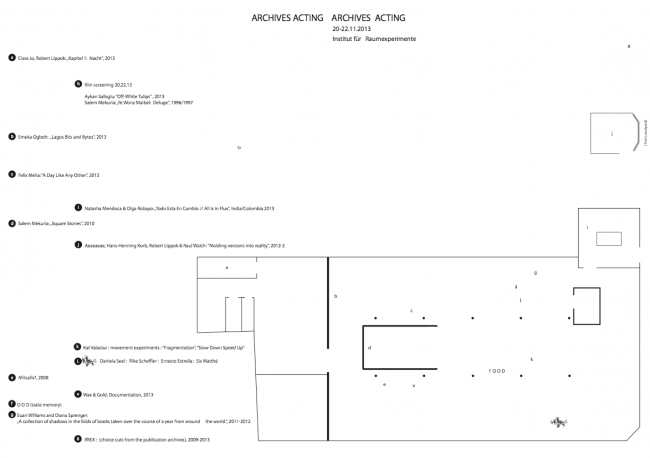
Archives Acting
Archives Acting is an exhibition curated on occasion of the Archives Works Marathon and hosted at the Institut für Raumexperimente and the Grey Sheep project housed at Studio Olafur Eliasson.
Archives Acting is choreographed by Eric Ellingsen and Christina Werner with contributions by Aeaeaeae, Hans-Henning Korb, Robert Lippok, and Raul Walch; Clara Jo and Robert Lippok; Salem Mekuria; Felix Melia; Natasha Mendonca and Olga Robayo; Netsa Art Village, Mihret Kebede, and Robel Temesgen; Emeka Ogboh; Elvira Dyangani Ose and Pere Ortín; Aykan Safoǧlu; Daniela Seel, Rike Scheffler, Ernesto Estrella, and Sis Matthé; Diana Sprenger and Euan Williams; and Kat Válastur.
Aeaeaeae, Hans-Henning Korb, Robert Lippok, and Raul Walch
Molding Versions into Reality, 2012-2013
Everything is knot together here. Everything hanging here comes from Ethiopia, even the things that come from China, and this is reality. This is the sound of reality snared and knotted together from stories and streets and markets and roundabouts in Addis Ababa. This is archive’s opposite, a moment of chaotic similarities. A sound installation as part of the Grey Sheep project.
Tainá Guedes, Asako Iwama, Lauren Maurer, and Lynn Peemoeller
f : O O D, 2013
Served in the context of the marathon days, these taste memory experiments, recipes, menus, and thoughts are provided by Tainá Guedes, Asako Iwama, Lauren Maurer, and Lynn Peemoeller. Menu designed by Thomas Meyer.
Clara Jo and Robert Lippok
24h Dahlem, Kapitel 1: Nacht, 2013
24h Dahlem centres on the controversial re-location of the ethnographic collections of the Dahlem Museums to the future site of the Humboldt Forum in Berlin’s city centre. Combining material from two archives within the Ethnological Museum and the Museum for Asian Art, the resulting large-scale video installations are presented in three chapters in the Dahlem Museum. 24h Dahlem was produced in the context of the Humboldt Lab Dahlem, a project of the German Federal Cultural Foundation and the Prussian Cultural Heritage Foundation.
Director: Clara Jo; sound design & audio archive composition: Robert Lippok; director of photography: Michael Laakmann
Felix Melia
A Day Like Any Other, 2013
A Day Like Any Other is a video work comprised of appropriated video and audio from the Aquis Bryant film Hood 2 Hood: The Blockumentary and Samuel Beckett’s Endgame. The video draws a comparison between the repetitive, cyclical nature of events in Beckett’s play and the similarly recurrent explanations and stories of ‘real’ life in Hood 2 Hood, stories that allude to the sedentary metaphysics and social immobility imposed upon its protagonists. The words ‘all day everyday’ literally encircle the imagery of the work. A commonly employed assertion within the appropriated footage, these words describe a refusal to give in, while highlighting the limited dynamic of the environments the protagonists inhabit.
Salem Mekuria
Ye Wonz Maibel: Deluge, 1996/1997
Ye Wonz Maibel: Deluge is a personal visual meditation on history, conflict, and the roads to reconciliation. It is a tale of love and betrayal, of idealism and the lure of power. It is a memorial to a brother who disappeared and a best friend, executed. It is a story of the Ethiopian students, their ‘revolution’, and its aftermath – a brutal military dictatorship. Ye Wonz Maibel: Deluge contemplates the role of the individual in perpetuating national tragedies – be that famine, war, or political terror – by re-visiting family tragedies in Ethiopia. Focusing on and searching through her own history, Mekuria sought personal experiences that illuminated universal truths. The film offers tools for reflection in order to look forward to a future in which responsibility and choice inform our conduct.
Salem Mekuria
Square Stories, 2010
Square Stories is a triptych video installation. Maskal Square (Revolution Square, or just ‘the Square’), located in the centre of Addis Ababa, Ethiopia, is a massive concrete expanse framed by permanent bleachers. It is the lowest point in the city: everything cascades into the Square. Everything big that happens in the city takes place there. The Square is also a site of commemoration, anchored by two museums that offer stable, corporealised narratives of the city and the nation. Square Stories offers a way of bearing witness to these multiple, fragmentary histories. It presents Maskal Square both as place and metaphor culled from a childhood in Addis Ababa and the gaze of an American art professor. The triptych format, which gestures to Ethiopia’s religious and cultural history, amplifies the contradictions within history, memory, and narration and interrogates the failure of any one story to stand in for the manifold subjectivities that comprise Ethiopian identity and history.
Writer/producer/videographer/director: Salem Mekuria; editor: Sarah B. Peck
Natasha Mendoca & Olga Robayo
Todo Esta En Cambio // All is in Flux, 2013
Todo Esta En Cambio navigates through sounds that seamlessly crisscross India and Colombia. This sonic journey takes us through the agrarian crisis and the consequences of the free trade treaty signed between India, Colombia, and the United States. The sound makes links between how food is produced in an industrialised world without consideration for the farmers, and how political leaders and corporations are leading the world to further environmental and socio-political disasters in the name of profit.
Netsa Art Village
Wax&Gold, 2013
Wax&Gold is a documentation of the Wax&Gold workshop for freedom of artistic expression that took place at Netsa Art Village and was accompanied by a touring exhibition in Addis Ababa, July 2012. Wax&Gold, a project developed and designed by Netsa Art Village and funded by the Prince Claus Fund, embraces the historical Ethiopian tradition of ‘Wax and Gold’, an approach involving indirect methods of communication, a strong form of expression in Ethiopian literature called ‘Qinie’, which obscures and protects the main message, the ‘Gold’, by covering it with ‘Wax’.
Presented by Mihret Kebede & Robel Temesgen.
Emeka Ogboh
Lagos Bits and Bytes, 2013
An electro-acoustic exploration of a bustling amphitheatre of sounds, a sprawling metropolis, and an aspiring megalopolis – Lagos, Nigeria. This is an excerpt from a Lagos soundscapes project, an acoustic enquiry into the mega-city focused on capturing sounds that define the unique character of Lagos and reflect the city’s diversity.
Elvira Dyangani Ose & Pere Ortín
Africalls?, 2008
Africalls? is a documentary film that shows the work of five artists and two production centres of contemporary art in seven African cities. It shows the interests that motivate them and the urban context from which they create their artworks. Africalls? approaches these artists’ work from an unusual perspective, exploring their personalities and creative processes as well as the art objects they make in Dakar, Douala, Cape Town, Rabat, Luanda, Nairobi, and Maputo. Africalls? is an audiovisual journey through the contemporary art of an urban Africa: both cosmopolitan and little-known, local and global.
Curator: Elvira Dyangani Ose; director: Pere Ortín; producer: Vic Pereiró
Aykan Safoǧlu
Off-White Tulips, 2013
Off-White Tulips is a tribute to the US-American writer James Baldwin. In this dense video essay, the artist links Baldwin’s self-imposed exile in Turkey with his own biographical details and an exploration of his native country. With the help of old photographs, we follow the path through Istanbul equally of James Baldwin as much as of Aykan Safoǧlu and his family. The emphasis on both personal stories quickly begins to blur fact and fiction. Safoǧlu calls this form biomythography – a type of invented life story coined by the American writer and activist Audre Lord, who described herself as a ‘black lesbian feminist mother warrior poet’. Off-White Tulips looks at history from marginal perspectives in order to explore alternative interpretations of cultural artefacts and differences, queer politics and identity. It is concerned with black survival strategies in a white mainstream. The film was awarded the Oberhausen Grand Prize at the Short Film Festival in Oberhausen in 2013.
Daniela Seel, Rike Scheffler, Ernesto Estrella, and Sis Matthé
L-A-N-G-U-A-G-I-N-G, 2013
L-A-N-G-U-A-G-I-N-G is a series of writing experiments and spontaneous language swerves informed by a space of listening. For two days, four poets tweeted echoes of what they heard from a listening space in the context of the Archives Works Marathon. The tweets can be found under the Twitter handle @Raumexperimente.
Diana Sprenger and Euan Williams
A Collection of Shadows in the Folds of Books Taken over the Course of a Year from Around the World, 2011-2012
In the folds of books. Reproduced shadows. Heightening the ephemeral quality of a book as a physical entity. A movable and borderless publication. Free of obvious geographical and temporal marks, yet created out of the temporal and geographical relationship between a source of light, an object, and the moment in which a photo is taken. A merging of real shadows with represented ones. Past mixes with present, as northern hemisphere mixes with southern hemisphere.
Kat Válastur
Fragmentation, Slow Down, Speed Up (Sketches), 2013
Movement experiments developed and demonstrated by the artist to collectively test moving in and against time
Institut für Raumexperimente
A presentation of selected visual material from the archives of the Institut für Raumexperimente, 2009-2013.
Archives Acting ist eine Ausstellung, die anlässlich des Archives Works Marathons kuratiert wurde und im Institut für Raumexperiemente sowie dem Grey Sheep Projekt im Studio Olafur Eliasson gezeigt wird.
Archives Acting wurde von Eric Ellingsen und Christina Werner choreografiert und zeigt Beiträge von Aeaeaeae, Hans-Henning Korb, Robert Lippok, und Raul Walch; Clara Jo und Robert Lippok; Salem Mekuria; Felix Melia; Natasha Mendonca und Olga Robayo; Netsa Art Village, Mihret Kebede und Robel Temesgen; Emeka Ogboh; Elvira Dyangani Ose und Pere Ortín; Aykan Safoǧlu; Daniela Seel, Rike Scheffler, Ernesto Estrella und Sis Matthé; Diana Sprenger und Euan Williams sowie Kat Válastur.
Aeaeaeae, Hans-Henning Korb, Robert Lippok und Raul Walch
Molding versions into reality, 2012-2013
Alles hier ist miteinander verknotet. Alles was hier hängt kommt aus Äthiopien, sogar die Dinge die aus China kommen und das ist die Realität. Das ist der Klang der Realität, eingefangen und zusammengeknotet aus Geschichten und Straßen und Märkten und Kreisverkehren in Addis Abeba. Das ist das Gegenteil des Archivs, ein Moment chaotischer Ähnlichkeiten. Eine Klanginstallation als Teil des Grey Sheep Projektes.
Tainá Guedes, Asako Iwama, Lauren Maurer und Lynn Peemoeller
f : O O D, 2013
Diese leckeren Erinnerungsexperimente, Rezepte, Menüs und Ideen werden im Rahmen der Marathon-Tage von Tainá Guedes, Asako Iwama, Lauren Maurer und Lynn Peemoeller aufgetischt. Entwurf des Menüs von Thomas Meyer.
Clara Jo und Robert Lippok
24h Dahlem, Kapitel 1: Nacht, 2013
24h Dahlem positioniert sich rund um die kontroverse Umsiedelung der ethnografischen Sammlung aus den Museen Dahlem an ihren zukünftigen Ort, das Humboldt Forum im Stadtzentrum Berlins. Mit einer Mischung aus Materialien zweier Archive des Ethnologischen Museums und des Museums für Asiatische Kunst werden die daraus entstandenen großformatigen Videoinstallationen in drei Kapiteln in den Museen Dahlem gezeigt. 24h Dahlem wurde im Rahmen des Humboldt Lab Dahlem produziert, einem Projekt der Kulturstiftung des Bundes und der Stiftung Preußischer Kulturbesitz.
Regie: Clara Jo; Sounddesign & und Komposition der Audioarchive: Robert Lippok; Kamera: Michael Laakmann
Felix Melia
A Day Like Any Other, 2013
A Day Like Any Other verwendet Video- und Audiomaterial des Films Hood 2 Hood: The Blockumentary von Aquis Bryant und Samuel Becketts Endspiel. Das Video zieht einen Vergleich zwischen der sich wiederholenden, zyklischen Struktur der Ereignisse in Becketts Stück und den genauso repetitiven Erklärungen und Geschichten des „echten“ Lebens in Hood 2 Hood. Dies sind Geschichten, welche auf die immobile Metaphysik und soziale Unbeweglichkeit hinweisen, welche den Protagonisten auferlegt sind. Die Formulierung „den ganzen Tag, jeden Tag“ umschreibt wortwörtlich die Bildwelten dieses Werks. Als wiederholte Beteuerung innerhalb der appropriierten Filmelemente steht diese Formulierung für Weigerung nachzugeben während sie gleichzeitig die eingeschränkte Dynamik der Umgebung, in der die Protagonisten sich befinden, herausstellt.
Salem Mekuria
Ye Wonz Maibel: Deluge, 1996/1997
Ye Wonz Maibel: Deluge ist eine persönliche, visuelle Meditation über Geschichte, Konflikten und Wegen, die zur Versöhnung führen. Es ist eine Geschichte über Liebe und Betrug, Idealismus und die Verführung der Macht. Es ist ein Denkmal an einen Bruder der verschwand und einen besten Freund der exekutiert wird. Erzählt wird die Geschichte der äthiopischen Studenten, ihrer „Revolution“ und dem was darauf folgt – eine brutale Militärdiktatur. Ye Wonz Maibel: Deluge denkt über die Rolle des Individuums in bestehenden nationalen Tragödien nach – das können Hungersnöte, Kriege oder politischer Terror sein – indem Familientragödien in Äthiopien neu betrachtet werden. Mit suchendem Fokus auf ihre eigene Geschichte greift Mekuria, persönliche Erfahrungen auf, die universelle Wahrheiten aufscheinen lassen.
Salem Mekuria
Square Stories, 2010
Square Stories ist eine Videoinstallation im Tryptichon-Format. Der Maskal Square Platz (Revolution Square oder einfach auch “the square”) liegt im Zentrum von Addis Abeba, Äthiopien, und ist eine große Betonfreifläche, die von fest installierten Tribünen begrenzt ist. Der Platz ist der niedrigstgelegene Punkt der Stadt: Alles läuft auf den Square zu. Alle großen Ereignisse in der Stadt finden hier statt. Der Platz ist auch ein Ort für Erinnerung. Zwei Museen, die hier Orientierungspunkte bieten stehen für konstante, verkörperte Narrationen der Stadt sowie der Nation. Square Stories bietet einen Zugang, um Zeugnis für diese vielseitigen, fragmentierten Geschichten abzulegen. Der Maskal Square wird sowohl als Platz als auch als Metapher präsentiert. Das Triptychon-Format, das der religiösen und kulturellen Geschichte Äthiopiens entlehnt ist, unterstreicht die Widersprüchlichkeit, die der Geschichte, der Erinnerung und der Narration zugrunde liegen. Gleichzeitig unterstreicht es, dass seither keine einzelne Geschichte repräsentativ für die vielseitigen Subjektivitäten, aus denen die äthiopische Identität und Geschichte bestehen, einstehen konnte.
Autor/Produzent/Kamera/Regie: Salem Mekuria; Schnitt: Sarah B. Peck
Natasha Mendoca & Olga Robayo
Todo Esta En Cambio // All is in Flux, 2013
Todo Esta En Cambio navigiert durch Klänge, die Indien und Columbien nahtlos im Zickzack durchqueren. Diese Klangreise nimmt uns mit durch eine Landwirtschaftskrise und deren Auswirkungen auf das freie Handelsabkommen zwischen Indien, Kolumbien und den Vereinigten Staaten. Der Klang stellt Verbindungen zwischen der Nahrungsmittelproduktion in einer industrialisierten Welt her, wo Bauern nicht mit in Betracht gezogen werden, und der Art, auf die Politiker und Firmen im Namen des Profits die Welt in weitere umwelttechnische und sozio-politische Desaster führen.
Netsa Art Village
Wax&Gold, 2013
Wax&Gold ist eine Dokumentation des Wax&Gold Workshops für die Freiheit künstlerischen Ausdrucks, der im Netsa Art Village stattfand und von einer Wanderausstellung in Addis Abeba im Juli 2012 begleitet wurde. Wax&Gold, ein Projekt das vom Netsa Art Village entwickelt und gestaltet wurde, sowie vom Prince Claus Fonds mitgetragen wird, übernimmt die historische äthiopische Tradition des “Wax & Gold”. Dieser Ansatz umfasst indirekte Kommunikationsformen, eine in der äthiopischen Literatur starken Ausdrucksform namens “Qinie”, welche die zu transportierende Aussage gleichermaßen verschleiert als auch schützt. Das “Gold” wird hier mit “Wachs” überzogen.
Präsentiert von Mihret Kebede & Robel Temesgen.
Emeka Ogboh
Lagos Bits and Bytes, 2013
Ein elektroakustischer Erkundungsgang durch ein klangerfülltes Theater, eine lebendige Metropole und eine aufstrebende Megalopole – Lagos in Nigeria. Dies ist ein Ausschnitt aus einem Projekt, das mit den Klanglandschaften Lagos arbeitet und eine akustische Befragung der Megastadt ist. Der Fokus liegt dabei darauf, Klänge einzufangen, die den einzigartigen Charakter der Stadt Lagos bestimmen und die Diversität der Stadt widerspiegeln.
Elvira Dyangani Ose & Pere Ortín
Africalls?, 2008
Africalls? ist ein Dokumentationsfilm, der die Arbeit von fünf Künstlern und zwei Produktionszentren für zeitgenössische Kunst in sieben afrikanischen Städten zeigt. Africalls? thematisiert die Arbeiten dieser Künstler aus einer ungewöhnlichen Perspektive, zeigt ihre Persönlichkeiten und Kreativprozesse sowie Kunstwerke, die sie in Dakar, Douala, Kapstadt, Rabat, Luanda, Nairobi und Maputo schaffen. Africalls? ist eine audiovisuelle Reise durch die zeitgenössische Kunst eines urbanen Afrikas: Kosmopolitisch und wenig bekannt, lokal und global.
Kurator: Elvira Dyangani Ose; Regisseur: Pere Ortín; Produktion: Vic Pereiró
Aykan Safoǧlu
Off-White Tulips, 2013
Off-White Tulips ist ein Homage an den amerikanischen Autor James Baldwin. In einem dichten Videoessay verbindet der Künstler Baldwinds selbstauferlegtes Exil in der Türkei mit Details aus seiner eigenen Biografie und einem Blick auf sein Heimatland. Mithilfe alter Fotografien folgen wir James Baldwin und Aykan Safoǧlu und dessen Familie gleichermaßen durch Istanbul. Der Fokus auf die persönlichen Geschichten von beiden lässt Fakt und Fiktion schnell verschwimmen. Safoǧlu nennt diese Form Biomythografie – eine Form der fiktiven Lebensgeschichte, begründet von der amerikanischen Autorin Audre Lord, die sich selbst als “black lesbian feminist mother warrior poet” bezeichnet. Off-White Tulips blickt aus marginalisierten Perspektiven auf die Geschichte um daraus alternative Interpretationen kultureller Artefakte und Differenzen sowie von Queer Politik und Identität zu ziehen. Das Werk befasst sich mit schwarzen Überlebensstrategien innerhalb eines weißen Mainstreams. Der Film wurde mit dem Oberhausen Grand Prix beim Kurzfilm-Festival 2013 in Oberhausen ausgezeichnet.
Daniela Seel, Rike Scheffler, Ernesto Estrella, und Sis Matthé
L-A-N-G-U-A-G-I-N-G, 2013
L-A-N-G-U-A-G-I-N-G ist eine Serie aus Schreibexperimenten und spontanen Sprachnotizen, beeinflusst von einem “Zuhörort”. Zwei Tage lang tweeteten vier Dichter Echos dessen was sie an diesem Ort im Rahmen des Archives Works Marathon hörten. Ihre Tweets finden sich bei Twitter unter @Raumexperimente.
Diana Sprenger und Euan Williams
A Collection of Shadows in the Folds of Books Taken over the Course of a Year from Around the World, 2011-2012
Zwischen den Falten von Buchseiten. Reproduzierte Schatten. Eine Unterstreichung der flüchtigen Eigenschaften von Büchern als physischer Einheit. Eine bewegliche und grenzenlose Publikation. Frei von offensichtlichen geografischen und zeitlichen Zeichen und doch aus der zeitlichen und geografischen Beziehung zwischen einer Lichtquelle, einem Objekt und dem Moment des Fotografierens entstanden. Eine Vermischung von echten Schatten mit den repräsentierten Schatten. Die Vergangenheit vermischt sich mit der Gegenwart genauso wie sich die nördliche Hemisphäre mit der südlichen Hemisphäre vermischt.
Kat Válastur
Fragmentation, Slow Down, Speed Up (Entwürfe), 2013
Experimente zu Bewegung, die von der Künstlerin entwickelt und vorgeführt wurden um kollektiv Bewegung in und gegen die Zeit zu testen.
Institut für Raumexperimente
Präsentation von ausgewählten Bild- und Publikationsmaterialien aus dem Institutsarchiv von 2009-2013.
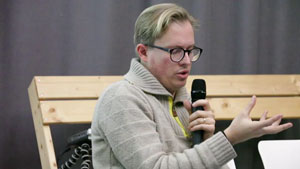
Nicola Setari
Nicola Setari discusses the issues surrounding the work he did for Visionary Africa and his collaboration with architect David Adjaye on GEO-Graphics. The presentation focuses on the itinerancy of Visionary Africa in different African capitals and on the many questions surrounding the representation of African culture within contemporary European institutions. Setari discusses the controversial notion of cultural restitution between European and African countries as well as the politics of working with existing ethnographic collections in Europe.
Synthesis
Visionary Africa · Bruno Latour · Iconoclash: Beyond the Image Wars in Science, Religion, and Art · The whole question of iconoclasm in contemporary culture has been a theme of reflection and investigation · Expand...
Visionary Africa · Bruno Latour · Iconoclash: Beyond the Image Wars in Science, Religion, and Art · The whole question of iconoclasm in contemporary culture has been a theme of reflection and investigation · Brussels: BOZAR Centre for Fine Arts and the Tervuren Museum · An opportunity to reflect on the problem of relations between European museums, ethnographic museums, and the African continent · On one side there was the theme of heritage and on the other side there was the question of visual stereotypes · British-Ghanaian architect, David Adjaye · Book: African Metropolitan Architecture – fifty-four capitals are reorganised according to climate zones on the continent, therefore liberating them of their national identity · The Atlas Research Project: a timeline mapping a hundred years of the evolution of policies on the management of culture on the African continent · GEO-Graphics: part of the bigger project Visionary Africa · Two main exhibitions: GEO-Graphics and A Useful Dream · Using colour codes and labels to decontextualise national identity
Short biography
Nicola Setari, researcher, curator, editor, and professor of visual anthropology at the Milan New Fine Arts and Design Academy. Expand...
Nicola Setari, researcher, curator, editor, and professor of visual anthropology at the Milan New Fine Arts and Design Academy. He was an agent of dOCUMENTA (13) in Kassel, Germany, contributing to the artistic and educational programme. He also co-edited part of the dOCUMENTA (13) catalogue – The Logbook (2012). Between 2006 and 2009, he was editor-in-chief and publisher of the cross-disciplinary art magazine Janus. In 2010 and 2011, he was co-curator of the Visionary Africa platform for the Centre for Fine Arts in Brussels and co-editor of David Adjaye’s GEO-Graphics: A Map of Art Practices in Africa, Past and Present (2010).
Nicola Setari thematisiert und diskutiert Visionary Africa und seine Zusammenarbeit mit dem Architekten David Adjaye für GEO-Graphics. Die Präsentation konzentriert sich auf die Reisen von Visionary Africa in verschiedene afrikanische Hauptstädte und auf die vielen Fragen rund um Repräsentationen afrikanischer Kultur durch zeitgenössische europäische Institutionen. Setari diskutiert kontroverse Zusammenhänge der kulturellen Entschädigung zwischen europäischen und afrikanischen Ländern sowie den Umgang mit ethnografischen Sammlungen in Europa.
Synthese
Visionary Africa · Bruno Latour · Iconoclash: Beyond the Image Wars in Science, Religion, and Art · Die Frage des Ikonoklasmus in der zeitgenössischen Kultur war eine Frage des Nachdenkens und Nachforschens · Expand...
Visionary Africa · Bruno Latour · Iconoclash: Beyond the Image Wars in Science, Religion, and Art · Die Frage des Ikonoklasmus in der zeitgenössischen Kultur war eine Frage des Nachdenkens und Nachforschens · Brüssel: BOZAR Centre for Fine Arts und das Tervuren Museum · Eine Gelegenheit über Probleme in den Beziehungen zwischen europäischen Museen, ethnografischen Museen und dem afrikanischen Kontinent nachzudenken · Einerseits Thema Kulturerbe und andererseits die Frage nach visuellen Stereotypen · British-Ghanaischer Architekt, David Adjaye · Buch: African Metropolitan Architecture – 54 Hauptstädte werden entsprechend den Klimazonen des Kontinentes neu geordnet und so von ihrer nationalen Identität befreit · The Atlas Research Project: Ein Zeitstrahl der Überblick gibt über die hundertjährige Evolution von Kulturmanagementpolitik auf dem afrikanischen Kontinent · GEO-Graphics: Teil des größeren Projektes Visionary Africa · Zwei große Ausstellungen: GEO-Graphics und A Useful Dream · Verwendung von Farbcodes und Etiketten zur Dekonstruktion nationaler Identität
Kurzbiografie
Nicola Setari, Kurator, Redakteur und Professor für visuelle Anthropologie an der New Fine Arts and Design Academy in Mailand. Expand...
Nicola Setari, Kurator, Redakteur und Professor für visuelle Anthropologie an der New Fine Arts and Design Academy in Mailand. Er war ein Agent der dOCUMENTA (13) in Kassel und trug zum künstlerischen Programm und zum Bildungsprogramm bei und zum Documenta-Katalog The Logbook (2012) bei. Zwischen den Jahren 2006 und 2009 war er Chefredakteur des interdisziplinären Kunstmagazins Janus. In den Jahren 2010 und 2011 war er Co-Kurator der Platform Visionary Africa am Centre for Fine Arts in Brüssel und Mitherausgeber von David Adjayes GEO-Graphics: A Map of Art Practices in Africa, Past and Present (2010).
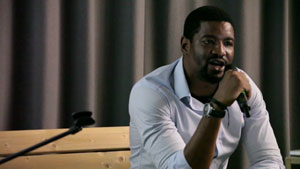
Emeka Obgoh
Emeka Ogboh presents work from the past few years in which he explores the soundscape of Lagos, Nigeria, by recording the sounds of the city and using this documentation as raw material for his installations. Lagos is a city under continuous change, and his artworks document these changes through the soundscape of the city.
Synthesis
Sound practice in relation to the city – Lagos • Documentation similar to archiving • 21 million people living in this 1000 kilometer-square space • The city is currently undergoing changes • Expand...
Sound practice in relation to the city – Lagos • Documentation similar to archiving • 21 million people living in this 1000 kilometer-square space • The city is currently undergoing changes • Started working on sound in Lagos in 2008 • Each city’s sound is really unique • There are no sound regulations • Ongoing sound project that explores Lagos as a vibrant African megacity • The lack of total silence in the city • The city as a composer: it composes the piece; Ogboh only documents • Various installations around Europe, experimenting with how non-Nigerians experience and react to the soundscape of Lagos • The city’s infrastructure is being updated to be more like European cities • The soundscape of the city is changing • Incorporating the Lagos bus driver, especially in the soundscape recording and installations; using the bus as an element for the installation • Working with composers to take sounds from Lagos and make music with it
Short biography
Emeka Ogboh, Nigerian artist with broad focuses on the notions of listening and hearing and who works primarily with sound and video to understand cities as cosmopolitan spaces with unique characters. Expand...
Emeka Ogboh, Nigerian artist with broad focuses on the notions of listening and hearing and who works primarily with sound and video to understand cities as cosmopolitan spaces with unique characters. His sound recordings also consider the history and aural infrastructure of cities, in particular Lagos, Nigeria, where he currently resides. These Lagos recordings have produced a corpus of work entitled Lagos Soundscapes, which he has variously installed in different foreign contexts. A graduate of the Department of Fine and Applied Arts, University of Nigeria, Nsukka, Ogboh has exhibited in several venues in Nigeria and internationally, including at the Centre for Contemporary Art, Lagos; Menil Collection, Houston; Whitworth and Manchester city galleries; MASS MoCA, Massachusetts; Kiasma Museum of Contemporary Art, Helsinki; and Rautenstrauch-Joest-Museum, Cologne. Ogboh is a 2014 recipient of a DAAD grant and the co-founder of the Video Art Network Lagos.
Emeka Ogboh stellt Arbeiten der letzten Jahre vor in denen er sich mit der Klanglandschaft von Lagos, Nigeria auseinandersetzt. Seine Tonaufnahmen dienen ihm als Rohmaterial für Installationen. Lagos ist eine Stadt die sich ständig verändert und seine Kunstwerke dokumentieren die Veränderungen anhand der Klanglandschaft der Stadt.
Synthese
Klangarbeit in Bezug zu Stadt – Lagos • Dokumentation ähnlich wie Archivieren • 21 Millionen Menschen leben auf diesem 1000 Quadratmeter großen Raum • Die Stadt verändert sich momentan • Expand...
Klangarbeit in Bezug zu Stadt – Lagos • Dokumentation ähnlich wie Archivieren • 21 Millionen Menschen leben auf diesem 1000 Quadratmeter großen Raum • Die Stadt verändert sich momentan • Begann im Jahr 2008 mit Klang zu Lagos zu arbeiten • Der Klang jeder Stadt ist einzigartig • Es gibt keine Klangregulationen • Ein fortlaufendes Soundprojekt das Lagos als lebendige afrikanische Megacity entdeckt • Die Abwesenheit völliger Stille in der Stadt • Die Stadt als Komponist: Sie komponiert das Stück, Ogboh dokumentiert nur • Verschiedene Installationen in Europa, experimentieren mit dem Erleben und der Reaktion auf Lagos Klangkulisse durch Nicht-Nigerianer • Die Infrastruktur der Stadt wird aktualisiert in die Richtung europäischer Städte • Die Klangkulisse der Stadt verändert sich • Einbeziehen der Busfahrer in Lagos, besonders für die Aufnahmen der Klangkulisse und Installationen, Nutzung des Busses als Installationsobjekt • Arbeit mit Komponisten um Klänge aus Lagos in Musik zu verarbeiten
Kurzbiografie
Emeka Ogboh, nigerianischer Künstler, der sich mit Hören und Zuhören auseinandersetzt. Er arbeitet hauptsächlich mit Sound und Video, Expand...
Emeka Ogboh, nigerianischer Künstler, der sich mit Hören und Zuhören auseinandersetzt. Er arbeitet hauptsächlich mit Sound und Video, um Städte als kosmopolitische Orte mit einzigartigem Charakter zu untersuchen. In seinen Soundaufnahmen beschäftigen er sich mit der Geschichte und der akustischen Infrastruktur von Städten, insbesondere seinem aktuellen Wohnort Lagos, Nigeria. Die Aufnahmen aus Lagos wurden als Werkserie mit dem Titel Lagos Soundscapes in verschiedenen Zusammenhängen präsentiert. Als Absolvent der Fakultät für bildende und angewandte Kunst der University of Nigeria, Nsukka, hat Ogboh in verschiedenen internationalen und nigerianischen Institutionen ausgestellt, unter anderem dem Centre for Contemporary Art in Lagos, der Menil Collection in Houston, den Whitworth and Manchester City Galleries, MASS MoCA in Massachusetts, dem Kiasma Museum of Contemporary Art in Helsinki und dem Rautenstrauch-Joest-Museum in Köln. Ogboh ist Mitbegründer des Video Art Network Lagos und erhielt im Jahr 2014 ein Stipendium des DAAD.
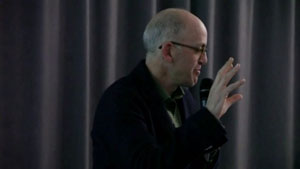
Jonathan Ledgard
Jonathan Ledgard raises several questions in relation to the arrival of new technologies and infrastructures in Africa and how these have an impact on African development, both culturally and politically. He also discusses how these technologies bring with them foreign interests and expectations, which have a direct effect on Africa as a whole.
Synthesis
Big ideas about archiving and memory • Working for The Economist • Joining love of Africa, technology, and creativity • The archiving of the human brain – reverse engineering • The Merowe people of Sudan have their archive in the elements • Expand...
Big ideas about archiving and memory • Working for The Economist • Joining love of Africa, technology, and creativity • The archival of the human brain – reverse engineering • The Merowe people of Sudan have their archive in the elements • Technology is not the be-all and end-all • A youthful China shakes hands with a shy Africa • The Nokia 1100 – the most influential technology in Africa in the last fifty years • Life recording – an entire life compressed and stored • IBM predicts a tsunami of data • How will future generations of Africans relate to their past? • Africa has a history of non-archival practice • Digital data implies the recording of the present • Attitudes toward Africa will have to change in the future • The dangers of digital identities being controlled by the state and corporations
Short biography
Jonathan Ledgard, thinker on near future nature, technology, and politics. Director of the Afrotech initiative at the Swiss Federal Institute of Technology in Lausanne, Expand...
Jonathan Ledgard, thinker on near future nature, technology, and politics. Director of the Afrotech initiative at the Swiss Federal Institute of Technology in Lausanne, where he works to pioneer advanced technologies on a massive scale in Africa through projects including the development of virtual coins and cargo robots. A long-time Africa correspondent for The Economist who has reported stories from 50 countries and on several wars, he is the author of two critically acclaimed novels, Giraffe (2006) and Submergence (2013).
Jonathan Ledgard hinterfragt die Einführung neuer Technologien und Infrastrukturen in Afrika und wie diese die Entwicklung in Afrika sowohl kulturell als auch politisch beeinflussen. Er diskutiert außerdem auf welche Weise diese Technologien fremde Interessen und Erwartungen mit sich bringen, die einen direkten Einfluss auf Afrika als Ganzes haben.
Synthese
Große Vorstellungen zu Archivierung und Erinnerung • Arbeit für The Economist • Verbindung einer Liebe zu Afrika, Technologie und Kreativität • Die Archivierung des menschlichen Gehirns – umgekehrte Konstruktion • Expand...
Große Vorstellungen zu Archivierung und Erinnerung • Arbeit für The Economist • Verbindung einer Liebe zu Afrika, Technologie und Kreativität • Die Archivierung des menschlichen Gehirns – umgekehrte Konstruktion • Das Merowe Volk aus Sudan hat sein Archiv in den Elementen • Technologie ist nicht die Lösung aller Dinge • Ein jugendliches China und ein schüchternes Afrika schütteln sich die Hände • Das Nokia 1100 – die einflussreichste Technologie der letzten 50 Jahre in Afrika • Aufnahmen vom Leben – ein gesamtes Leben komprimiert und gespeichert • IBM sagt einen Datentsunami voraus • Welche Beziehung werden die zukünftigen Generationen in Afrika zu ihrer Vergangenheit haben? • Afrika hat eine Geschichte nicht-archivierender Praktiken • Digitale Daten implizieren eine Aufnahme der Gegenwart • Einstellungen gegenüber Afrika werden sich in Zukunft ändern müssen • Die Gefahr, dass digitale Identitäten vom Staat und von Firmen kontrolliert werden
Kurzbiografie
Jonathan Ledgard denkt über die Themen Natur, Technologie und Politik in naher Zukunft nach. Als Direktor der Afrotech Initiative am Swiss Federal Institute of Technology in Lausanne, Expand...
Jonathan Ledgard denkt über die Themen Natur, Technologie und Politik in naher Zukunft nach. Als Direktor der Afrotech Initiative am Swiss Federal Institute of Technology in Lausanne, arbeitet er daran, fortgeschrittene Technologien im großangelegten Pionierprojekt in Afrika einzusetzen. Projekte die das ermöglichen sollen sind unter anderem die Entwicklung virtueller Münzen und Lastenroboter. Als langjähriger Afrikakorrespondent für The Economist, der Geschichten aus 50 Ländern und zu verschiedenen Kriegssituationen berichtete, ist er außerdem Autor zweier von der Kritik gefeierten Romane, Giraffe (2006) und Submergence (2013).
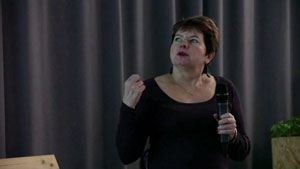
Cynthia Kros
Cynthia Kros speaks about the Apartheid Archive in South Africa and the issues that surround the formation and reception of such an institution. Her presentation raises questions in relation to memory and the urban space, especially with regard to the instalment of public sculptures, as well as questions in relation to the Truth and Reconciliation Commission, and how to bring personal stories to light.
Synthesis
The Apartheid Archives in South Africa • The issues of reading such an archive that was generated by those in power • How to memorialise the oppressed? • Brenda Fassie • Expand...
The Apartheid Archives in South Africa • The issues of reading such an archive that was generated by those in power • How to memorialise the oppressed? • Brenda Fassie • The role of large statues in generating and fixating memories • Changing street names as a political tool • Hector Pieterson Memorial and Museum • The personal stories of ordinary people – how to keep them? • The acceptance of different kinds of truth • The complexity of truth and its relation to a historical archive • The Truth and Reconciliation Commission • Bringing personal stories to light
Short biography
Cynthia Kros, historian, heritage specialist, and professor at the University of the Witwatersrand, Johannesburg. Expand...
Cynthia Kros, historian, heritage specialist, and professor at the University of the Witwatersrand, Johannesburg. Among other subjects, her research focuses on South African memorials and oral history. Her selected publications include the South African Historical Journal, for which she has served as co-editor since 2006, Great People, Great Places (2009), and The Seeds of Separate Development: Origins of Bantu Education (2010).
Cynthia Kros spricht über das Apartheid-Archiv in Südafrika. Sie thematisiert aktuelle Probleme der Gestaltung einer solchen Institution und welche Reaktion dabei ausgelöst werden. Ihre Präsentation berührt Fragen zu Erinnerung und urbanem Raum, besonders in Bezug öffentliche Skulpturen und Installationen. Sie beschäftig sich mit Wahrheits- und Versöhnungskommissionen, und wie diese persönliche Geschichten ans Licht bringen.
Synthesis
The Apartheid Archives in South Africa • Die Probleme beim Lesen eines solchen Archives, das von den Machthabern geschaffen wurde • Wie erinnert man an die Unterdrückten? • Brenda Fassie • Expand...
The Apartheid Archives in South Africa • Die Probleme beim Lesen eines solchen Archives, das von den Machthabern geschaffen wurde • Wie erinnert man an die Unterdrückten? • Brenda Fassie • Die Rolle großer Statuen bei der Schaffung und Fixierung von Erinnerungen • Das Ändern von Straßennamen als politisches Werkzeug • Hector Pieterson Memorial and Museum • Die persönlichen Geschichten normaler Mernschen – wie können sie bewahrt werden? • Das Akzeptieren verschiedener Arten von Wahrheit • Die Komplexität von Wahrheit und deren Beziehung zu einem historischen Archiv • Die Wahrheits- und Versöhnungskommission • Persönliche Geschichten ans Licht bringen
Kurzbiografie
Cynthia Kros, Historikerin, Spezialistin für Denkmäler und Professorin an der University of the Witwatersrand, Johannesburg. Expand...
Cynthia Kros, Historikerin, Spezialistin für Denkmäler und Professorin an der University of the Witwatersrand, Johannesburg. Unter anderem beschäftigt sich ihre Forschung mit südafrikanischen Denkmälern und mündlich überlieferter Geschichte. Ihre ausgewählten Publikationen umfassen das South African Historical Journal für welches sie als Mitherausgeberin seit 2006 tätig ist, Great People, Great Places (2009), und The Seeds of Separate Development: Origins of Bantu Education (2010).
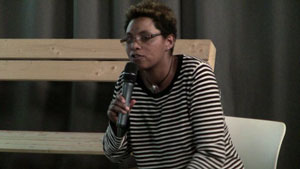
Mihret Kebede
Mihret Kebede presents her work on the concept of generations. She discusses the need for her own generation to become more politically involved in the transformation process of Addis Ababa.
Synthesis
Working with the idea of generations • Three generations: the past, the present, and the future • The past is more colourful • The ideology of the ruling party is more focused on ethnicity • Expand...
Working with the idea of generations • Three generations: the past, the present, and the future • The past is more colourful • The ideology of the ruling party is more focused on ethnicity • People represent more than just physical appearance and language • People often stand silently, looking and watching what’s taking place in the city • The need for more involvement from this generation • Finding opportunities for involvement in the development process • Power or money allow true freedom of expression in the city • Billboards as art project • Description and images of the work
Short biography
Mihret Kebede, artist, founding director of the Netsa Art Village artist collective in Addis Ababa. She is the recipient of numerous grants Expand...
Mihret Kebede, artist, founding director of the Netsa Art Village artist collective in Addis Ababa. She is the recipient of numerous grants including residencies at the Maryland Institute College of Art (2006), the Thami Mnyele Foundation (2012), and Deveron Arts, Huntly, Scotland (2012). Her recent projects include Slow Marathon and the Walk Sans Frontières Symposium (2012) on art, walking, and boundaries, and a performance art project for the Prince Claus Foundation annual awards ceremony in Amsterdam, Netherlands (2012). She is co-organiser of the Wax & Gold workshop and exhibition, Addis Ababa (2013), and she is a founding member of Tobiya Poetic Jazz Group.
Mihret Kebede präsentiert ihre Arbeit an einem Generationenkonzept. Sie diskutiert die Notwendigkeit für ihre eigene Generation, sich politisch mehr in den Veränderungsprozess Addis Abebas einzumischen.
Synthese
Arbeit zum Generationenverständnis • Drei Generationen: Vergangenheit, Gegenwart und Zukunft • Die Vergangenheit ist bunter • Die Ideologie der herrschenden Partei konzentriert sich mehr auf ethnische Merkmale • Expand...
Arbeit zum Generationenverständnis • Drei Generationen: Vergangenheit, Gegenwart und Zukunft • Die Vergangenheit ist bunter • Die Ideologie der herrschenden Partei konzentriert sich mehr auf ethnische Merkmale • Menschen repräsentieren mehr als nur äußerliche Erscheinungen und Sprache • Menschen bleiben oft stehen und beobachten stumm was in der Stadt passiert • Die Notwendigkeit von mehr Einmischung dieser Generation • Gelegenheiten für Einmischung in den Entwicklungsprozess finden • Macht oder Geld erlauben wahre Ausdrucksfreiheit in der Stadt • Werbeflächen als Kunstprojekte • Beschreibung und Bilder der Arbeit
Kurzbiografie
Mihret Kebede, Künstlerin, Gründungsdirektorin des Netsa Art Village Künstlerkollektivs in Addis Abeba. Sie hat zahlreiche Auszeichnungen erhalten, Expand...
Mihret Kebede, Künstlerin, Gründungsdirektorin des Netsa Art Village Künstlerkollektivs in Addis Abeba. Sie hat zahlreiche Auszeichnungen erhalten, unter anderem Residencies am Maryland Institute College of Art (2006), der Thami Mnyele Foundation (2012) und Deveron Arts in Huntley, Schottland (2012). Ihre aktuellen Projekte sind unter anderem Slow Marathon und das Walk Sans Frontières Symposium (2012) zu Kunst, Laufen und Grenzen, sowie ein Performancekunstprojekt für die jährliche Prince Claus Foundation Preisverleihung in Amsterdam, Niederlande (2012). Sie ist Mitorganisatorin des Wax & Gold Workshops sowie der gleichnamigen Ausstellung in Addis Abeba (2013) und sie ist Gründungsmitglied der Tobiya Poetic Jazz Group.

Elizabeth Giorgis
Elizabeth Giorgis focuses on the progressive loss of city archives in Addis Ababa due to the rapid modernisation of the city and questions the place and role of young artists in this transformation. She examines the effects that these transformations have on the local communities and how artists’ works can draw attention to these changes. She presents and discusses the work of artists Michael Tesfaye, Mihret Kebede, and Berhanu Ashagrie Deribew.
Synthesis
The Institute of Ethiopian Studies • The manipulation of archives • Addis Ababa undergoing urban transformation • Archives being erased as a result • Expand...
The Institute of Ethiopian Studies • The manipulation of archives • Addis Ababa undergoing urban transformation • Archives being erased as a result • Young artists questioning their identity in relation to the past of Addis Ababa • European colonialists tried to erase African archives • The Chinese are attempting to do the same • Africa transcends • Artist Michael Tesfaye • How to talk about the future being disconnected from the past • City’s future development contrasted against its poorer past and present • Indigenous structures replaced by poor quality modern constructions • Communities being dismantled • Cemeteries cleared to make way for roads • Menelik Palace • Power existing alongside poverty • Clearing areas for development • The effects this has on the local population • Artist Mihret Kebede • The hidden and the apparent • Powerful work of performance by young artists in Addis Ababa • Questioning the use of advertising in the public space • Artist Berhanu Ashagrie Deribew • The interchange of space and place • The homogenisation of public space according to international aesthetic standards • Real censorship vs. self-censorship • The Changing DNA of Addis Ababa – Goethe-Institut
Short biography
Elizabeth Giorgis, art historian, professor, and preeminent scholar on the subject of Ethiopian art and culture. Expand...
Elizabeth Giorgis, art historian, professor, and preeminent scholar on the subject of Ethiopian art and culture. She holds a PhD from the Department of History of Art and Visual Studies of Cornell University, an MA in Museum Studies from New York University, and has written extensively on Ethiopian art. As a curator, Giorgis has presented exhibitions at the Modern Art Museum and the Museum of the Institute of Ethiopian Studies, both in Addis Ababa. She was most recently a Visiting Professor in the Humanities at the Cogut Center at Brown University, Providence, USA.
Elizabeth Giorgis konzentriert sich auf den Verlust von Stadtarchiven in Addis Abeba als Folge der schnell fortschreitenden Modernisierung der Stadt und hinterfragt die Position und Rolle junger Künstler innerhalb dieses Wandels. Sie untersucht die Folgen, welche diese Veränderungen für lokale Gemeinschaften haben und fragt wie künstlerische Arbeit Aufmerksamkeit auf diese Veränderungen ziehen kann. Sie präsentiert und diskutiert die Arbeit der Künstler Michael Tesfaye, Mihret Kebede und Berhanu Ashagrie Deribew.
Synthese
The Institute of Ethiopian Studies • Die Manipulation des Archivs • Addis Abeba erlebt eine urbane Transformation • Als Folge werden Archive ausgelöscht • Expand...
The Institute of Ethiopian Studies • Die Manipulation des Archivs • Addis Abeba erlebt eine urbane Transformation • Als Folge werden Archive ausgelöscht • Junge Künstler hinterfragen ihre Identität in Bezug auf Addis Abebas Vergangenheit • Europäische Kolonialisten haben versucht afrikanische Archive auszulöschen • Chinesen versuchen dasselbe • Afrika transzendiert • Künstler Michael Tesfaye • Wie kann man über die Trennung zwischen Zukunft und Vergangenheit sprechen? • Zukünftige Entwicklungen der Stadt im Kontrast zu seiner ärmeren Vergangenheit und Gegenwart • Indigene Strukturen werden von qualitative minderwertigen modernen Bauvorhaben ersetzt • Gemeinschaften werden auseinandergenommen • Friedhöfe werden geräumt um Platz für Straßen zu machen • Menelik Palace • Macht die neben Armut existiert • Orte für Stadtentwicklung räumen • Der Einfluss, den dies auf die Bevölkerung vor Ort hat • Künstlerin Mihret Kebede • Das Versteckte und das Offensichtliche • Wirkungsstarke Performancearbeiten junger Künstler in Addis Abeba • Hinterfragen der Verwendung von Werbung im öffentlichen Raum • Der Künstler Berhanu Ashagrie Deribew • Der Austausch von Raum und Ort • Die Homogenisierung des öffentlichen Raums nach internationalen ästhetischen Standards • Echte Zensur versus Selbstzensur • The Changing DNA of Addis Ababa – Goethe Institut
Kurzbiografie
Elizabeth Giorgis, Kunstgeschichtlerin, Professorin und Wissenschaftlerin auf dem Gebiet äthiopischer Kunst und Kultur. Expand...
Elizabeth Giorgis, Kunstgeschichtlerin, Professorin und herausragende Wissenschaftlerin auf dem Gebiet äthiopischer Kunst und Kultur. Sie hat einen PhD vom Institut für Kunstgeschichte und Bildstudien der Cornell University, einen MA in Museumskunde der New York University und hat ausgiebig zu äthiopischer Kunst geschrieben. Als Kuratorin präsentierte Giorgis Ausstellungen am Modern Art Museum und dem Museum of the Institute of Ethiopian Studies, beides in Addis Abeba. Sie ist Gastprofessorin für Geisteswissenschaften am Cogut Center der Brown University in Providence, USA.
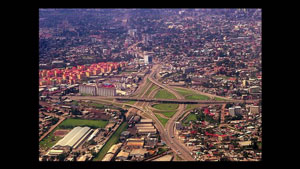
Fasil Giorghis
Fasil Giorghis presents the issues facing Addis Ababa and its rapid transformation in the 21st century, touching on themes of colonisation, archival culture, and memory preservation.
Synthesis
The importance of archives in the work of architects, city planners, and thinkers • Images of the rapid transformation of Addis Ababa • Tabula rasa approach to development in some areas • Expand...
The importance of archives in the work of architects, city planners, and thinkers • Images of the rapid transformation of Addis Ababa • Tabula rasa approach to development in some areas • Anti-neoliberal policies in Addis Ababa • Western style training in architecture, no focus on local culture • Description of the history of Addis Ababa from 125 years ago • Images of Addis Ababa from European archives • The opening of the country to foreign influence after 1000 years • The Italian invasion of 1936 and its effects • Architecture and planning as tools of colonisation • Addis Ababa is not a segregated city, but segregation is developing • ‘Red Terror’ Martyrs’ Memorial Museum • Rescuing historic buildings • The role of archives in the ongoing debate for cultural preservation
Short biography
Fasil Giorghis, architect and chair of conservation of urban and architectural heritage at EiABC, Addis Ababa University. Expand...
Fasil Giorghis, architect and chair of conservation of urban and architectural heritage at EiABC, Addis Ababa University. He has worked on the study and preservation of the architectural heritage of Ethiopia, from traditional housing to historic towns. In 2008, he published a book entitled Addis Ababa: The City and its Urban and Architectural Heritage from 1886-1941. He has designed hotels, cultural centres, commercial buildings, and private residences around the country, including the ‘Red Terror’ Martyrs’ Memorial Museum in Addis Ababa. Typical of his designs are the use of local materials and indigenous knowledge combined with a great concern for his designs’ impact on the environment.
Fasil Giorghis spricht über die Probleme, mit denen Addis Abeba angesichts seiner schnellen Veränderungen im 21. Jahrhundert zu kämpfen hat. Weitere Themen sind hierbei Kolonialisierung, Archivkulturen und Erinnerungsbewahrung.
Synthese
Die Bedeutsamkeit von Archiven für die Arbeit von Architekten, Stadtplanern und Theoretikern • Bilder des schnellen Wandels in Addis Abeba • Tabula rasa Ansatz für die Entwicklung einiger Gegenden • Expand...
Die Bedeutsamkeit von Archiven für die Arbeit von Architekten, Stadtplanern und Theoretikern • Bilder des schnellen Wandels in Addis Abeba • Tabula rasa Ansatz für die Entwicklung einiger Gegenden • Anti-neoliberale Politik in Addis Abeba • Westlich orientierte Ausbildung in Architektur, kein Focus auf lokale Kultur • Beschreibung der Geschichte Addis Abebas ab einem Zeitpunkt von vor 125 Jahren • Bilder von Addis Abeba aus europäischen Archiven • Die Öffnung des Landes für fremde Einflüsse nach 1000 Jahren • Die italienische Invasion von 1936 und ihre Folgen • Architektur und Planung als Werkzeuge der Kolonialisierung • Addis Abeba ist keine geteilte Stadt, aber Rassentrennung nimmt zu • ‘Red Terror’ Martyrs’ Memorial Museum • Rettung historischer Gebäude • Die Rolle von Archiven in der aktuellen Debatte zu kultureller Bewahrung
Kurzbiografie
Fasil Giorghis ist Architekt und Konservator für urbane und architektonische Denkmäler an der EiABC Addis Ababa University. Expand...
Fasil Giorghis ist Architekt und Konservator für urbane und architektonische Denkmäler an der EiABC Addis Ababa University. Er hat zur Erforschung und Erhaltung von Architekturdenkmälern in Äthiopien gearbeitet, von traditionellen Häusern bis hin zu historischen Städten. Im Jahr 2008 veröffentlichte er ein Buch mit dem Titel Addis Ababa: The City and its Urban and Architectural Heritage from 1886-1941. Er hat Hotels, Kulturzentren, kommerzielle Gebäude und private Wohnhäuser im gesamten Land entworfen einschließlich dem ‘Red Terror’ Martyrs’ Merorial Museum in Addis Abeba. Kennzeichnend für seine Entwürfe sind die Verwendung von lokalen Materialien und indigenem Wissen in Kombination mit einem großen Bewusstsein für den Einfluss seiner Entwürfe auf die Umwelt.
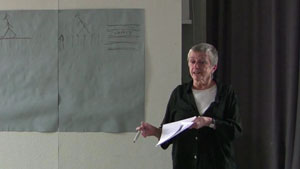
Doreen Massey: Space and Responsibility
Doreen Massey presents a lecture with running discussion, where she puts forward four propositions to be expanded upon and discussed with the audience. These are 1) space is full of time, 2) to be more outward-looking, 3) space is the dimension of multiplicity, and 4) the necessity to keep space open and alive. Within this framework several subjects are explored, such as the relation between space and time and the political implications of this relation; the relation between the local and the global; the need to change established worldviews; how to re-conceptualise space as a political dimension; and how to keep space open for new political possibilities.
Synthesis
A critique of neoliberalism · Making space social · Proposition 1 – space is full of time · We should not counterpose space and time · Space is temporalised · So why does that matter? · Expand...
A critique of neoliberalism · Making space social · Proposition 1 – space is full of time · We should not counterpose space and time · Space is temporalised · So why does that matter? · The reason it matters is that it brings space alive · Space is not just a product of our actions · Spatial organisation has effects · It feeds back into the organisation of society · Space is a responsibility · We must deliberate about the spaces we make because they have effects · Implicitly we always think of space as a surface · The crossing of space to discover new cultures – a European view of the world · That’s not correct · If space is temporal then we walk across a multitude of stories · Space is a cut across a multitude of stories · That automatically complicates walking · The discovery of new cultures was a meeting of different trajectories · A lot of neoliberal critique of space is a critique of a point on a timeline · Generally a critique of the past · Museums follow this practice · It closes the past, encloses it · Patrick Keiller · Films that are walks · A recognition that stories continue · Space is not a surface it is a multiplicity of stories so far · Walking across space is to walk past several on going stories · The past is unfinished, it continues to pose questions for us today · Spatial Divisions of Labour · The interpretation of the past is a political activity · There is an active reconstruction of the past, an active forgetting · The reconceptualisation of space is a political activity · Science Bytes · Seeking a Gestalt shift · The narrative of progress is linear · Difference is organised in a historical sequence · These are the grand narratives · Once the grand narrative is specialised then it opens up to the possibility of political alternatives · Proposition 2 – to be more outward-looking · There is an awareness of the planet unparalleled in history · Contrasted by a total self-absorption · This must be challenged · The concept of identity and the relational aspect of identity construction initiated this · Every place is a hybrid construction · ‘A Global Sense of Place’ · Following relations around the world to see what our relationship is to these other parts of the world · The global shapes the local and the local shapes the global · We need a politics of arrivals and departures in terms of the relation between localities · A local politics of arrival and a global politics of departure · What is happening with migration? · A global ‘free’ labour market is emerging · We must become less self-absorbed in order to become critical of this emergent model · Personal reorientation · What are the processes for this to happen? · There are no fixed points · Anti-foundationalism · Anti-essentialism · How to get it across? · Proposition 3 – space is the dimension of multiplicity · Time is the dimension of the coexistence of trajectories of ‘nows’ · It is the dimension of our togetherness · Space imposes the most fundamental of political questions which is: how are we going to live together? · Space is the grounding dimension of the social · Radical contemporaneity – coevalness · A coexistence in time · In the grand narrative there is only one “now” · The multiplicity of views is the challenge that space sets for us · Chantal Mouffe · In order for there to be politics there must be opposition · Proposition 4 – the necessity to keep space open and alive · For there to be politics and democracy there must be no final point
Short biography
Doreen Massey, an Emeritus Professor at the Open University since 2009, remains active in a number of areas, most notably Expand...
Doreen Massey, an Emeritus Professor at the Open University since 2009, remains active in a number of areas, most notably the AHRC project The future of landscape and the moving image with Patrick Keiller of the Royal College of Art and Professor Patrick Wright of Nottingham Trent University. Her ongoing book project Voices of Places, based on her Clarendon Lectures given at Oxford in 2008, is forthcoming from Oxford University Press. She is pursuing continuing interests in space and power through engagement with political change in Venezuela, where the concept of power-geometries has been taken up as part of the effort to extend grassroots and participatory democracy. She is a member of the Editorial Board for the journal Revista Pós at the School of Architecture and Urbanism of São Paulo, Brazil.
Doreen Massey präsentiert einen Vortrag, in dem sie vier Vorschläge macht, die mit dem Publikum diskutiert werden. Diese sind 1) Raum ist voll von Zeit, 2) Wir sollen uns mehr nach Außen orientieren, 3) Raum ist die Dimension von Vielfältigkeit, und 4) Wir müssen die Notwendigkeit anerkennen, Raum offen und lebendig zu erhalten. Innerhalb dieses Rahmens werden mehrere Themengebiete erforscht wie beispielsweise die Beziehung zwischen Raum und Zeit und die politischen Implikationen dieser Beziehung; die Beziehung zwischen dem Globalen und dem Lokalen; die Notwendigkeit etablierte Weltsichten zu ändern. Wie kann Raum als politische Dimension rekonzeptualisiert werden? Wie kann Raum für neue politische Möglichkeiten offen gehalten werden?
Synthese
Kritik an Neoliberalismus · Einen Ort sozial machen · Vorschlag 1 – Raum ist voll von Zeit · Wir sollten Raum und Zeit einander nicht gegenüberstellen · Raum ist verzeitlicht · Warum also ist das wichtig? · Expand...
Kritik an Neoliberalismus · Einen Ort sozial machen · Vorschlag 1 – Raum ist voll von Zeit · Wir sollten Raum und Zeit einander nicht gegenüberstellen · Raum ist verzeitlicht · Warum also ist das wichtig? · Der Grund weswegen es wichtig ist, ist dass es Raum als etwas Lebendiges zurückbringt · Raum ist nicht nur ein Produkt unserer Handlungen · Räumliche Organisation hat Auswirkungen · Sie hat eine Rückwirkung auf die Organisation der Gesellschaft · Wir müssen über die Räume, die wir schaffen nachdenken · Denn sie haben alle Auswirkungen · Implizit denken wir Raum immer als Oberfläche · Das Durchqueren von Raum um neue Kulturen zu entdecken – und die europäische Weltsicht · Das stimmt nicht · Wenn Raum zeitlich ist dann bewegen wir uns über eine Vielzahl an Geschichten · Raum ist ein Querschnitt durch eine Vielzahl an Geschichten · So wird Laufen automatisch komplizierter · Die Entdeckung neuer Kulturen war ein Aufeinandertreffen unterschiedlicher Laufbahnen · Vieles der neoliberalen Kritik von Raum ist die Kritik eines Punktes auf einem Zeitstrahl · Grundsätzlich eine Kritik der Vergangenheit · Museen arbeiten nach dieser Praxis · Es schließt die Vergangenheit, umschließt es · Patrick Keiller · Filme, die Spaziergänge sind · Wahrnehmen dass Geschichten weitergehen · Raum ist keine Oberfläche sondern bis auf weiteres eine Vielzahl an Geschichten · Durch den Raum zu laufen bedeutet an mehreren fortlaufenden Geschichten vorbeizugehen · Die Vergangenheit ist unvollendet, sie gibt uns weiterhin Fragen für unser Heute auf · Spatial Divisions of Labour · Die Interpretation der Vergangenheit ist eine politische Tätigkeit · Es gibt eine aktive Rekonstruktion der Vergangenheit und ein aktives Vergessen · Die Rekonzeptualisierung von Raum ist eine politische Tätigkeit · Science Bytes · Eine Veränderung von Gestalt anstreben · Die Narration von Fortschritt ist linear · Differenz ist in historischen Sequenzen organisiert · Das sind die großen Erzählungen · Sobald die große Erzählung spezialisiert ist, öffnet sie sich für die Möglichkeit politischer Alternativen · Vorschlag 2 – Sich mehr nach Außen orientieren · Es gibt ein im Verlauf der Geschichte bisher so nie dagewesenes Bewusstsein für den Planeten · Im Kontrast dazu steht eine totale Selbstbezogenheit · Dies muss in Frage gestellt werden · Den Anfang dafür machte das Identitätskonzept und der Aspekt der Identitätskonstruktion · Jeder Ort ist ein hybrides Konstrukt · ‘A Global Sense of Place’ · Beziehungen weltweit verfolgen, um unsere Beziehung zu diesen anderen Teilen der Welt sehen zu können · Das Globale formt das Lokale und das Lokale formt das Globale · Wir brauchen eine Politik der Ankunft und der Abreise wenn es um die Beziehungen zwischen Orten geht · Eine lokale Politik der Ankunft und eine globale Politik der Abreise · Was passiert mit Migration? · Ein globaler ‘freier’ Arbeitsmarkt entwickelt sich · Wir müssen weniger selbstbezogen werden, um diesem entstehenden Modell kritisch gegenüber zu stehen · Persönliche Neuausrichtung · Welche Prozesse sind notwendig damit dies passiert? · Es gibt keine Fixpunkte · Anti-Fundamentalismus · Anti-Essentialismus · Aber wie bringt man das rüber? · Vorschlag 3 – Raum ist die Dimension von Vielfältigkeit · Zeit ist die Dimension der Koexistenz von Laufbahnen des pluralen ‘Jetzt’ · Es ist die Dimension unseres Zusammenseins · Raum setzt die grundlegendste aller politischen Fragen voraus, welche ist: Wie werden wir zusammenleben? · Raum ist die fundamentale Dimension des Sozialen · Radikale Gleichzeitigkeit – Zeitgleichheit · Eine Koexistenz in der Zeit · In den großen Erzählungen gibt es nur ein ‘Jetzt’ · Die Vielfalt von Ansichten ist eine Herausforderung, die der Raum an uns stellt · Chantal Mouffe · Damit es Politik geben kann muss es eine Opposition geben · Vorschlag 4 – Die Notwendigkeit, Raum offen und lebendig zu halten · Damit es Politik und Demokratie gibt darf es keinen Endpunkt geben
Kurzbiografie
Doreen Massey, seit 2009 emeritierte Professorin der Open University, ist weiterhin in vielen Bereichen aktiv. Expand...
Doreen Massey,seit 2009 emeritierte Professorin der Open University, ist weiterhin in vielen Bereichen aktiv. Hiervon ist das AHRC Projekt The future of landscape and the moving image mit Patrick Keiller vom Royal College of Art und Professor Patrick Wright von der Nottingham Trent University das herausragendste. Ihr aktuelles Buchprojekt Voices of Places basiert auf den Claredon Lectures, die sie im Jahr 2008 in Oxford hielt und wird demnächst von Oxford University Press veröffentlicht. Sie verfolgt weiterhin ihre Interessen zu Themen von Raum und Macht durch ihr Engagement für politische Veränderungen in Venezuela. Dort ist ihr Konzept über Machtgeometrien aufgegriffen worden, um Grassroots- und partizipative Demokratiebewegung auszubauen. Sie ist Redaktionsmitglied der Zeitschrift Revista Pós an der School of Architecture and Urbanism in São Paulo, Brasilien.
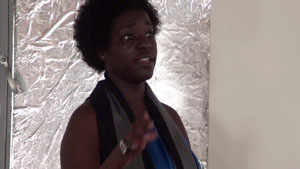
Elvira Dyangani Ose: Collective Art Practices
part I
part II
part III
Elvira Dyangani Ose presents a series of works by African artists as a basis for a discussion with a group of students from Addis Ababa and Berlin. Several questions and issues are raised in relation to curatorial practices such as how an artist’s biography influences the collection of his or her work; the building of public space; the role of art in society; ‘African-ness’; Jürgen Habermas’s concept of public space; the use of public space by artists; the breakdown between centre and periphery in the art world; the politics of labelling world art in order to make it collectible; and the Western artist as opposed to the non-Western artist.
Synthesis
Question of identity · Post-colonialism · Growing up in Spain and studying art history · How artists deal with public space · How artists use their own biography to deal with public space · Expand...
Question of identity · Post-colonialism · Growing up in Spain and studying art history · How artists deal with public space · How artists use their own biography to deal with public space · What influences the collectability of art? · The influence of history and theory of architecture on Dyangani Ose’s curatorial career · Collective-ness is a central issue today · What is the role of the artist in society? · Do African artists present a notion of ‘African-ness’? · Researching African art · Dyangani Ose’s work with Tate Modern and her focus on African art · Can artists claim the public sphere as theirs? · Artist collectives around Africa · Cultural platforms that show what is happening in different African cities · Using borrowed spaces to show artists’ work · Using the public space to blur the boundaries between artist and viewer · Interdisciplinary approach to art production · Political awareness through art · First Festival of Black Art in Dakar 1966 · Initial cultural policy for African art · Raising the question of how to understand “African art” · Defining differences between how Africans see their own art in relation to how the West sees it · New internationalism · The breakdown between centre and periphery · A single mega show cannot fully represent what Africa is · Important to look at specific contexts · Who can judge “African-ness”?
Short biography
Elvira Dyangani Ose is a Lecturer in Visual Cultures at Goldsmiths, University of London, and curator of the eighth Göteborg International Biennial for Contemporary Art, GIBCA 2015. Expand...
Elvira Dyangani Ose is a Lecturer in Visual Cultures at Goldsmiths, University of London, and curator of the eighth Göteborg International Biennial for Contemporary Art, GIBCA 2015. From 2011 to 2014, she served as Curator of International Art at Tate Modern. Prior to her work at Tate, she was curator from 2004 to 2006 at the Centro Atlántico de Arte Moderno (CAAM), Las Palmas la Gran Canaria, Spain, and from 2006 to 2008 at the Centro Andaluz de Arte Contemporáneo (CAAC), Seville. At the CAAM, she curated works by, among others, Nicholas Hlobo, Tracey Rose, Moshekwa Langa, Zanele Muholi, and Mikhael Sutbozky. She has curated the retrospective exhibition Carrie Mae Weems: Social Studies at CAAC (2010) and the interdisciplinary project Attempt to Exhaust an African Place at Centre d’Art Santa Mònica, Barcelona (2007–2008). She was also guest curator of the triennial SUD – Salon Urbain de Douala, Douala, Cameroon (2010), and the Artistic Director of the third Rencontres Picha: Lubumbashi Biennial, Democratic Republic of Congo (2013). Dyangani Ose has published and lectured on modern and contemporary African art and has contributed to art journals such as NKA and Atlántica.
Teil I
Teil II
Teil III
Elvira Dyangani Ose präsentiert eine Reihe von Arbeiten afrikanischer Künstler, die als Diskussionsgrundlage für die Gruppe der Studierenden der Alle School of Fine Arts and Design und des Instituts für Raumexperimente dienen. Es werden Fragen in Bezug auf kuratorische Praktiken gestellt, so etwa: Welchen Einfluss hat die Biographie eines Künstlers darauf, ob seine Werke gesammelt werden? Welchen Einfluss hat das Labeln von internationaler Kunst, um diese sammelbar zu machen? Desweiteren werden Fragen zum Entstehen öffentlichen Raums und der Rolle von Kunst in der Gesellschaft gestellt. Fragen, die ebenfalls diskutiert werden, lauten: Existiert Jürgen Habermas Konzept vom öffentlichen Raum? Wie nutzen Künstler öffentlichen Raum? Gibt es Afrikanizität? Gibt es Entkopplung von Zentrum und Peripherie in der Kunstwelt? Was ist ein westlicher, beziehungsweise nicht-westlicher Künstler?
Synthese
Identitätsfragen · Postkolonialismus · In Spanien aufwachsen, hat Kunstgeschichte studiert · Wie gehen Künstler mit öffentlichem Raum um? · Arten, auf die Künstler ihre eigenen Biographie in Interaktion mit öffentlichem Raum nutzen · Expand...
Identitätsfragen · Postkolonialismus · In Spanien aufwachsen · Hat Kunstgeschichte studiert · Wie gehen Künstler mit öffentlichem Raum um? · Arten, auf die Künstler ihre eigenen Biographie in Interaktion mit öffentlichem Raum nutzen · Was beeinflusst die Sammelbarkeit von Kunst? · Geschichte und Architekturtheorie beeinflussen ihre kuratorische Laufbahn · Kollektivität ist heute ein zentrales Thema · Was ist die Rolle des Künstlers in der Gesellschaft? · Repräsentieren afrikanische Künstler eine Form von Afrikanizität? · Recherche zu afrikanischer Kunst · Beginnt bei Tate Modern zu afrikanischer Kunst zu arbeiten · Können Künstler öffentlichen Raum für sich beanspruchen? · Künstlerkollektive in Afrika · Kulturelle Plattformen, die zeigen was in afrikanischen Städten passiert · Geliehene Orte zur Ausstellung von Kunstwerken · Nutzung des öffentlichen Raums um die Grenzen zwischen Künstlern und Publikum zu verwischen · Interdisziplinärer Ansatz in Sachen Kunstproduktion · Politisches Bewusstsein durch Kunst · First Festival of Black Art in Dakar 1966 · Erste Kulturpolitik für afrikanische Kunst · Frage danach wie „afrikanische Kunst“ verstanden werden kann · Differenzen zwischen dem Verständnis von afrikanischer Kunst durch Afrikaner im Gegensatz zum Westen definieren · Neuer Internationalismus · Zusammenbruch der Trennung zwischen Zentrum und Peripherie · Eine einzige große Ausstellung kann nicht zeigen was afrikanische Kunst ist · Es ist wichtig spezifische Zusammenhänge zu betrachten · Wer legt fest was „afrikanisch“ bedeutet ?
Kurzbiografie
Elvira Dyangani Ose ist Lehrende für visuelle Kultur am Goldsmiths College der University of London und Kuratorin der achten Ausgabe der Göteborg International Biennial for Contemporary Art, GIBCA 2015. Expand...
Elvira Dyangani Ose ist Lehrende für visuelle Kultur am Goldsmiths College der University of London und Kuratorin der achten Ausgabe der Göteborg International Biennial for Contemporary Art, GIBCA 2015. Sie war von 2011 bis 2014 Kuratorin für Internationale Kunst an der Tate Modern. Zuvor war sie Kuratorin des Centro Atlántico de Arte Moderno (2004 – 2006) und am Centro Andaluz de Arte Contemporáneo (2006 – 2008). Am CAAM kuratierte sie die wegweisende Ausstellung Olvida Quien Soy / Erase Me From Who I Am (2006) und zeigte hier unter anderem Werke von Nicholas Hlobo, Tracey Rose, Moshekwa Langa, Zanele Muholi und Mikhael Sutbozky. Sie kuratierte die retrospektive Ausstellung Carrie Mae Weems: Social Studies (2010) und das interdisziplinäre Projekt Attempt to Exhaust an African Place (2007–2008). Sie war außerdem Kuratorin von Arte Invisible (2009–2010), Gastkuratorin der Triennale SUD-Salon Urbain de Douala (2010) und künstlerische Leiterin der dritten Ausgabe von Rencontres Picha: Lubumbashi Biennial (2013), Demokratische Republik Kongo. Dyangani Ose publiziert zu moderner und zeitgenössischer afrikanischer Kunst, hält Vorträge und verfasst regelmäßig Beiträge für Kunstmagazine wie NKA und Atlántica.
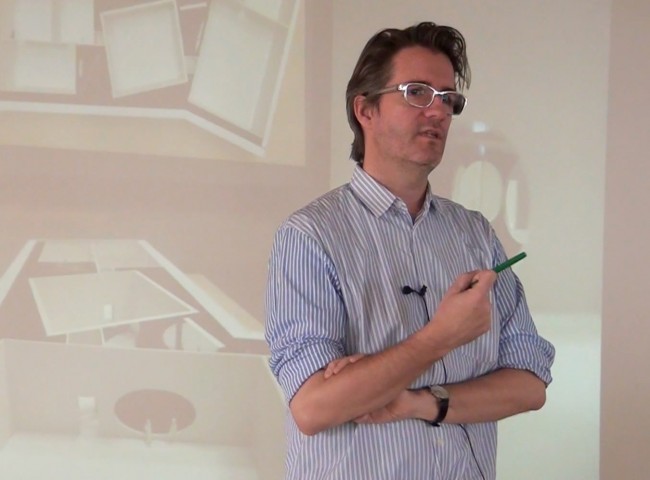
Olafur Eliasson: Third Lecture
Teil I
Teil II
Teil III
Olafur Eliasson continues his discussion of the challenges confronting contemporary artists, framed in a retrospective on his career so far. Eliasson speaks of the power and effect of environments, the way those environments are constructed and conditioned, and the need to understand one’s environment as a subjective and negotiable event. This is the third of four lectures given by the artist in Addis Ababa in the context of an education collaboration between the Institut für Raumexperimente and the Alle School of Fine Arts and Design.
Synthesis
Marathon: compilation of independent things that still overlap • Getting into the flow • Navigation is the artists’ challenge • The effect of context on a work of art • Belief • Expand...
Marathon: compilation of independent things that still overlap • Getting into the flow • Navigation is the artists’ challenge • The effect of context on a work of art • Belief • Passion • Noticing emotions reminds us that we are not alone • Unconscious mirroring of emotional environments • Confidence • Glass creating an inside and an outside • Glass as highly alienating and excluding • Looking through walls • Borrowed views in Chinese gardens • Lalibela void • Artists’ ability to see an ‘invisible’ space • Omgivelser, an exhibition in-between walls • Separating artworks from consumer goods • A space where our subconscious can be explored • Your house • The notion of negative spaces as positive spaces • Being so busy making sense of what we see that we don’t see most of what’s out there • Simulating various light conditions to re-exercise our vision • The influence of lighting on our perception of colour • The historical conditioning of white • Associating white with purity: the use of lime in hospitals and the whitewashing of Protestant churches during the Reformation • Experimental set-ups with light: Your relativity of white, The light setup • Room for one colour • Broadening one’s point of view • The feeling that we are not the centre of the universe • Light is not without context • Light as a discursive practice • How a work of art evolves in the world • Art and artists as part of and bound up with an often invisible system
Short biography
Olafur Eliasson, Danish-Icelandic artist, founded the Institut für Raumexperimente, an educational research project, Expand...
Olafur Eliasson, Danish-Icelandic artist, founded the Institut für Raumexperimente, an educational research project, affiliated with the College of Fine Arts at the Berlin University of the Arts (UdK). The fundamental trajectory of the Institut für Raumexperimente is Eliasson’s interest in testing models of learning and cultivating experimental formats.
part I
part II
part III
Olafur Eliasson führt seine Überlegungen zu den Herausforderungen vor denen zeitgenössische Künstler stehen weiter aus. Er setzt dies in Bezug zu einer Retrospektive seiner bisheriger Arbeiten. Eliasson spricht über die Kraft und den Einfluss, die unsere Umwelt auf uns hat, die Art auf die diese Umgebungen konstruiert und konditioniert sind und das Bedürfnis die eigene Umgebung als subjektives und verhandelbares Ereignis zu verstehen. Der Vortrag ist der dritte von insgesamt vier Vorträgen, die der Künstler im Rahmen einer Zusammenarbeit des Institutes für Raumexperimente mit der Alle School of Fine Arts and Design in Addis Abeba hielt.
Synthese
Marathon: Zusammenstellung unabhängiger Dinge, die immer noch Schnittpunkte haben • In den Flow kommen • Navigation ist die Herausforderung des Künstlers • Der Effekt von Kontext auf ein Kunstwerk • Glaube • Expand...
Marathon: Zusammenstellung unabhängiger Dinge die immer noch Schnittpunkte haben • In den Flow kommen • Navigation ist die Herausforderung des Künstlers • Der Effekt von Kontext auf ein Kunstwerk • Glaube • Leidenschaft • Gefühle zu bemerken erinnert uns daran, dass wir nicht allein sind • Unbewusstes spiegeln von emotionalen Umgebungen • Zutrauen • Glas, das ein Innen und ein Außen schafft • Glas als zutiefst entfremdend und ausschließend • Durch Wände sehen • "borrowed view" in chinesischen Gärten • Lalibela void • Die Fähigkeit des Künstlers, einen ‘unsichtbaren’ Ort zu sehen • Omgivelser, eine Ausstellung zwischen Wänden • Kunstwerke von Konsumgütern trennen • Ein Ort, an dem unser Unterbewusstes erforscht werden kann • Your house • Das Verständnis von negativen Räumen als positiven Räumen • So beschäftigt damit sein, den Dingen die wir sehen einen Sinn zu geben, dass wir das meiste gar nicht sehen • Simulation verschiedener Lichtverhältnisse um unser Sehen neu zu trainieren • Der Einfluss von Beleuchtung auf unsere Farbsicht • Die historische Konditionierung von Weiß • Assoziation von Weiß mit Reinheit: Der Gebrauch von Kalk in Krankenhäusern und das Weißen evangelischer Kirchen während der Reformation • Experimentelle Aufbauten mit Licht: Your relativity of white, The light setup • Room for one colour • Erweiterung des eigenen Blickwinkels • Das Gefühl, dass wir nicht das Zentrum des Universums sind • Licht ist nicht ohne Kontext • Licht als diskursive Praxis • Wie sich ein Kunstwerk in der Welt entwickelt • Kunst und Künstler als Teil eines oft unsichtbaren Systems, in dem sie verstrickt sind
Kurzbiografie
Olafur Eliasson, dänisch-isländischer Künstler, gründete das Institut für Raumexperimente, ein Studien- und Forschungsprojekt, Expand...
Olafur Eliasson, dänisch-isländischer Künstler, gründete das Institut für Raumexperimente, ein Studien- und Forschungsprojekt, das Teil der Fakultät für Bildende Kunst an der Universität der Künste Berlin (UdK) ist. Eliassons Interesse, neue Lernmodelle zu testen und experimentelle Formate zu kultivieren, ist grundlegender Bestandteil des Institutsprogramms.

Addis Art Practices Marathon
The Addis Art Practices Marathon takes place at the Alle School of Fine Art and Design, Addis Ababa University, in the context of the institute’s ten-week-long presence in Addis Ababa. Participating guests speak about their backgrounds and the directions in which their interests are leading them. Additionally, they present case studies that reflect their practices, approaches, and experiences in relation to the questions below. The initial short statements and examples facilitate multilayered discussions throughout the course of the marathon, focused on contemporary art practices in Addis Ababa.
Part I: Key questions
What is the position from which you practice and support art today, and what is the potential as well as the responsibility of art in 21st-century Addis Ababa?
Part II: Initial questions for the open discussion
What is the responsibility of art education?
What does it means to be an artist in Addis Ababa?
What are the options for young art practices in Addis Ababa today?
What are the visions?
What are the resources and assets in arts in Ethiopia (as well as in Africa and the global art market)?
Guest speakers: Seyoum Ayalew and Adam Michael, Ethiopian Visual Artist Association; Grima Bulti, National Museum of Ethiopia; Aida Muluneh, Addis Foto Fest; Eshetu Tiruneh, Enlightment Art Academy; Berhanu Ashagrie Deribew, Alle School of Fine Art and Design; Mihret Kebede, Netsa Art Village; Aklilu Temesgen, Five Art Studio; Meskerem Assegued, ZOMA Contemporary Art Center; moderated by Eric Ellingsen and Christina Werner, Institut für Raumexperimente
Der Addis Art Practices Marathon findet an der Alle School of Fine Art and Design, Addis Abeba University im Rahmen eines zehnwöchigen Austausches mit dem Institut für Raumexperimente statt. Teilnehmende Gäste sprechen hier über ihren Hintergrund und die Richtungen, in die ihre Interessen sie führen. Zusätzlich stellen sie Fallstudien vor, die relevant für Praktiken, Ansätze und Erfahrungen im Bezug zu untenstehenden Fragen sind. Ihre kurzen Statements und Beispiele ermöglichen eine vielschichtige Diskussion mit Fokus auf zeitgenössische Kunstpraktiken in Addis Abeba.
Teil I: Hauptfragen
Aus welcher Position heraus praktizierst und unterstützt Du heute Kunst? Welches Potential und welche Verantwortung hat Kunst im Addis Abeba des 21. Jahrhunderts?
Teil II: Ausgangsfrage für die offene Diskussion
Welche Verantwortung hat künstlerische Bildung?
Was bedeutet es, in Addis Abeba Künstler zu sein?
Welche Möglichkeiten gibt es heutzutage in Addis Abeba für junge Kunstschaffende?
Was sind die Visionen?
Was sind die Ressourcen und Vorteile für Kunst in Äthiopien (sowie in Afrika und auf dem globalen Markt)?
Gastteilnehmer: Seyoum Ayalew und Adam Michael, Ethiopian Visual Artist Association; Grima Bulti, Äthiopisches Nationalmuseum; Aida Muluneh, Addis Foto Fest; Eshetu Tiruneh, Enlightment Art Academy; Berhanu Ashagrie Deribew, Alle School of Fine Art and Design; Mihret Kebede, Netsa Art Village; Aklilu Temesgen, Five Art Studio; Meskerem Assegued, ZOMA Contemporary Art Center; moderiert von Eric Ellingsen und Christina Werner, Institut für Raumexperimente
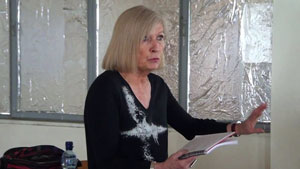
Chantal Mouffe: Agonistic Spaces
part I
part II
Chantal Mouffe presents a lecture on the basic tenets of her theory of politics and how artistic practices can intervene in political processes. She first lays the philosophical ground for her lecture: the critique of Essentialism and an introduction to a discursive approach, touching on the work of Freud, Lacan, Wittgenstein, and Gadamer. Secondly, she introduces and discusses her theory of an agonistic model of democracy. In this framework, she explores the role of artistic practice within the political process and its ability to intervene and help change established hegemonies through antagonistic positioning.
Synthesis
Where can artistic practice intervene? · Some philosophical concepts that are important to have as a basis · Sigmund Freud · The subject is a given, an idea questioned by critical essentialism · The concept of the divided subject between the conscious and the unconscious · Psychoanalysis can help to reach the unconscious but can never master it · Ludwig Wittgenstein – the subject cannot be the source of linguistic meaning · Expand...
Where can artistic practice intervene? · Some philosophical concepts that are important to have as a basis · Sigmund Freud · The subject is a given, an idea questioned by critical essentialism · The concept of the divided subject between the conscious and the unconscious · Psychoanalysis can help to reach the unconscious but can never master it · Ludwig Wittgenstein – the subject cannot be the source of linguistic meaning · It is by participating in a variety of practices that the world is revealed to us · Hans-Georg Gadamer · It is by participating in languages that the world is disclosed to us · Pragmatism · There is no identity already there · Identity is constructed · Jacques Lacan · The subject is like an onion, constructed by layers of identification · The discursive approach – reality is always constructed through various discourses or signifying practices · Reality is only a product of discourse · Discourse is an articulation between linguistic things and material things · The object is always given to us by discursive articulation · The meaning of things is always constructed through a system of relations · Kicking a ball only becomes playing football when it is within a particular system of relations · Antonio Gramsci · The category of hegemony · A system of relations is always a system of power · There is no society without power · The structures can be changed but not eliminated · Every type of order is an hegemonic structure · Counter-hegemonic practices offer alternatives · There is always an alternative to the existing order · That is where artistic practices can act · Two main concepts – hegemony and antagonism · The aim of democracy is to establish a rational consensus · This is impossible, because if every order is hegemonic then there can be no reconciliation, only alternatives through antagonism · What are the consequences of this approach to democracy? · The task for political institutions is to aggregate interests and establish consensus · The pursuit of self-interest · Rational choice · John Rawls · Jürgen Habermas · To act as a citizen is to act towards the common good · Must differentiate between instrumental and communicative rationality · The role of passion in creating a collective form of identification · Affect is not irrational · We can accept a democratic model that encompasses antagonism · Democratic institutions within this model do not seek a rational consensus · Antagonism is a very specific form of conflict, one which can never reach a consensus · Antagonism in this democratic model can exist as a conflict between adversaries instead of enemies · They accept the legitimacy of their opponents · Not with the aim of destroying the other · The democratic process is accepted within the agonistic model · The opponent is treated as an equal · A process of persuasion to win over the opponent · There are competing views of the common good · Different agonistic spaces allow for different types of individualities to exist · The hegemonic model is particularly good to understand the relation between art and politics · Gramsci posited that hegemonies are created through civil society · Through a multiplicity of practices · The importance of culture in the creation and reproduction of the common sense · Our subjectivity is dependent on the types of practices in which we participate · Art and politics not separate from each other · They either contribute to the existent hegemony or they critique it · How can artistic practices have a critical position within traditional institutions today?
Short biography
Chantal Mouffe, political theorist educated at the universities of Louvain, Paris, and Essex, is professor of political theory at the University of Westminster. Expand...
Chantal Mouffe, political theorist educated at the universities of Louvain, Paris, and Essex, is professor of political theory at the University of Westminster. She has taught at many universities in Europe, North America, and Latin America and has held research positions at Harvard, Cornell, the University of California, the Institute for Advanced Study in Princeton, and the Centre National de la Recherche Scientifique in Paris. Between 1989 and 1995, she was Directrice de Programme at the College International de Philosophie in Paris. Professor Mouffe is module leader of the CSD MA modules The State, Politics and Violence and Current Issues in Democratic Theory at the University of Westminster.
Teil I
Teil II
Chantal Mouffe hält einen Vortrag über die Grundlagen ihrer politischen Theorie und darüber wie künstlerische Praktiken in politische Prozesse eingreifen können. Zuerst legt sie die philosophische Grundlage für ihren Vortrag: Eine Kritik des Essentialismus und eine Einführung in die diskursive Theorie mit Erwähnung der Werke von Freud, Lacan, Wittgenstein und Gadamer. Danach führt sie in ihre Theorie eines agonistischen Demokratiemodells ein und diskutiert diese. Sie hinterfragt die Rolle künstlerischer Praxis innerhalb von politischen Prozessen und deren Fähigkeit einzugreifen und zur Veränderung von etablierten Herrschaftssystemen durch antagonistische Positionierung beizutragen.
Synthese
Wo kann künstlerische Praxis eingreifen? · Einige philosophische Konzepte die als Basis wichtig sind · Sigmund Freud · Dass das Subjekt gegeben ist wird vom kritischen Essentialismus in Frage gestellt · Konzept des geteilten Subjektes zwischen Bewusstsein und Unbewusstsein · Psychoanalyse kann helfen das Unbewusste zu erreichen, es aber nie beherrschen · Ludwig Wittgenstein – Das Subjekt kann keine Quelle linguistischer Bedeutung sein · Expand...
Wo kann künstlerische Praxis eingreifen? · Einige philosophische Konzepte die als Basis wichtig sind · Sigmund Freud · Dass das Subjekt gegeben ist wird vom kritischen Essentialismus in Frage gestellt · Konzept des geteilten Subjektes zwischen Bewusstsein und Unbewusstsein · Psychoanalyse kann helfen das Unbewusste zu erreichen, es aber nie beherrschen · Ludwig Wittgenstein – Das Subjekt kann keine Quelle linguistischer Bedeutung sein · Die Welt erschließt sich uns durch die Teilnahme an einer Vielzahl von Praktiken · Hans-Georg Gadamer · Durch Sprache eröffnet sich uns die Welt · Pragmatismus · Es gibt keine Identität von vornherein · Identität ist konstruiert · Jacques Lacan · Das Subjekt gleicht einer Zwiebel · Das Subjekt setzt sich aus Identifikationslagen zusammen · Der diskursive Ansatz – Realität wird durch verschiedene Diskurse oder bedeutungssetzende Praktiken geschaffen · Realität ist lediglich ein Produkt von Diskursen · Diskurs ist eine Artikulation zwischen linguistischen Dingen und materiellen Dingen · Das Objekt erhalten wir immer durch diskursive Artikulation · Die Bedeutung von Dingen wird immer durch ein Beziehungssystem geschaffen · Einen Ball zu treten wird erst dann zum Fußball spielen wenn es Teil eines besonderen Beziehungssystems ist · Chantal Mouffes Ansatz · Antonio Gramsci · Hegemonie als Kategorie · Soziale Beziehungen werden immer durch Artikulation, durch Beziehungen geschaffen · Dieses Beziehungssystem ist immer ein Machtsystem · Es gibt keine Gesellschaft ohne Macht · Strukturen können geändert werden, aber nicht ausgelöscht · Jede Art von Ordnung ist eine hegemonische Ordnung · Gegenhegemonische Praktiken bieten eine Alternative · Es gibt immer eine Alternative zur bestehenden Ordnung · Dort können künstlerische Praktiken agieren · Zwei Hauptkonzepte – Hegemonie und Antagonismus · Ziel der Demokratie ist die Etablierung eines rationale Konsens · Das ist unmöglich denn wenn jede Ordnung eine Hegemonie ist kann es keine Übereinstimmung geben, nur Alternativen durch Antagonismus · Was sind die Konsequenzen aus diesem Demokratieverständnis? · Die Aufgabe für politische Institutionen ist es Interessen anzusammeln und einen Konsens zu etablieren · Das Verfolgen eines Eigennutzes · Rationale Entscheidung · John Rawls · Jürgen Habermas · Als Bürger zu handeln bedeutet für das Gemeinwohl zu handeln · Es muss zwischen rein funktionaler und kommunikativer Rationalität unterschieden werden · Die Rolle von Leidenschaft bei der Erschaffung einer kollektiven Identifikationsform · Affektive Dimension · Affekt ist nicht irrational · Wir können ein demokratisches Modell das Antagonismen einschließt akzeptieren · Demokratische Institutionen innerhalb dieses Modells suchen nicht nach einem rationalen Konsens · Die Rolle von demokratischen Institutionen ist demnach sich zu etablieren um so Antagonismen zulassen zu können ohne dabei die demokratische Ordnung zu zerstören · Antagonismus ist eine sehr spezifische Form des Konflikts, die nie einen Konsens erreichen kann · In diesem demokratischen Modell kann Antagonismus als Konflikt zwischen Gegenspielern statt Feinden bestehen · Eine antagonistische Beziehung ist die Art von Konflikt die zwischen Gegenspielern besteht · Sie akzeptieren die Legetimität ihres Gegenüber · Ohne das Ziel den anderen zu zerstören · Der demokratische Prozess wird im agonistischen Modell akzeptiert · Im liberalen Modell ist der Gegenspieler ein Konkurrent · Der Gegenüber wird als gleichwertig behandelt · Ein Überzeugungsprozess um über den Gegenspieler zu siegen · Es gibt Ansichten über das Allgemeinwohl, die miteinander im Wettstreit stehen · Unterschiedliche antagonistische Räume ermöglichen die Existenz unterschiedlicher Arten von Individualitäten · Das hegemonistische Modell ist besonders gut um die Beziehung zwischen Kunst und Politik zu verstehen · Gramsci postulierte, dass Hegemonien durch die Zivilgesellschaft geschaffen werden · Durch eine Vielzahl an Praktiken · Die Wichtigkeit von Kultur für die Schaffung und Reproduktion gesunden Menschenverstandes · Unsere Subjektivität hängt von den Praktiken an denen wir teilhaben ab · Kunst und Politik sind nicht voneinander getrennt · Sie tragen entweder zur bestehenden Hegemonie bei oder kritisieren sie · Wie kann künstlerische Praxis innerhalb traditioneller Institutionen heute eine kritische Position haben?
Kurzbiografie
Chantal Mouffe, Politikwissenschaftlerin mit Ausbildung an den Universitäten Louvain, Paris und Essex ist Professorin für politische Theorie an der University of Westminster. Expand...
Chantal Mouffe, Politikwissenschaftlerin mit Ausbildung an den Universitäten Louvain, Paris und Essex. Sie ist Professorin für politische Theorie und Modulleiterin des CSD MA Moduls ‘The State, Politics and Violence and Current Issues in Democracy Theory’ an der University of Westminster. Sie lehrte an zahlreichen Universitäten in Europa, Nordamerika und Lateinamerika und hatte Forschungspositionen in Harvard, Cornell, der University of California, dem Institute for Advanced Studies in Princeton und am Centre National de la Recherche Scientifique in Paris inne. Zwischen 1989 und 1995 war sie Programmdirektorin des College International de Philosophie in Paris.
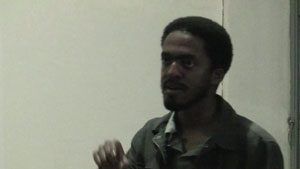
Brook Teklehaimanot: Addis and its Urbanism
part I
part II
part III
Brook Teklehaimanot delivers a detailed technical presentation on the urban development of Addis Ababa from its beginnings in the 19th century up to the present day. After a series of maps that detail the growth patterns of the city, he then moves to a number of photographs of modern-day Addis Ababa that examine different social and urban issues. The discussion also focuses on the relationship between neoliberal capitalism and contemporary city growth.
Synthesis
Addis Ababa and urbanism • Demographics and history of the city • Historical influences on the city’s development • Ethnic versus geographic boundaries • Expand...
Addis Ababa and urbanism • Demographics and history of the city • Historical influences on the city’s development • Ethnic versus geographic boundaries • Roads and transportation infrastructure: organic • Zoning and functional division of the city • Population density • Living conditions across Addis • Mixed forms of transportation in the city with very dense transit corridors • Idiosyncrasies affecting urban development: Ethiopian shoppers
Short biographyBrook Teklehaimanot, a professor in the chair of Architecture and Design at Addis Ababa University, is director of the EiABC protoLAB, a centre with interests in design and fabrication techniques and on the urban development of Addis Ababa.
Teil I
Teil II
Teil III
Brook Teklehaimanot hält einen technisch detaillierten Vortrag zur Stadtentwicklung Addis Abebas, angefangen im 19. Jahrhundert bis in die Gegenwart. Nach einem Einstieg mit einer Reihe von Karten die die Wachstumsmuster der Stadt zeigen, geht er zu einer Serie Fotografien über, die Addis Abeba heute zeigen und verschiedene soziale und urbane Gegebenheiten untersuchen. Die Diskussion bezieht sich außerdem auf die Beziehung zwischen neoliberalem Kapitalismus und zeitgenössischem Stadtwachtum.
Synthese
Addis Abeba und Urbanismus • Demographie und Geschichte der Stadt • Geschichtliche Einflüsse auf die Stadtentwicklung • Expand...
Addis Abeba und Urbanismus • Demographie und Geschichte der Stadt • Geschichtliche Einflüsse auf die Stadtentwicklung • Ethnische vs. geographische Grenzen • Straßen- und Beförderungsinfrastruktur: organisch • Aufteilung und funktionale Einteilung der Stadt • Bevölkerungsdichte • Lebensbedingungen in allen Teilen von Addis • Gemischte Art der Beförderung in der Stadt mit sehr dichten Routen • Empfindlichkeiten beeinflussen die Entwicklung urbanen Raums: Äthiopier sind nicht gewohnt, Läden in oberen Stockwerken zu suchen • Informelle wirtschaftliche Aktivitäten: Märkte im Freien • Gebäude dienen oft nur zu Werbezwecken und als Lagerräume während Handel fast ausschließlich draußen stattfindet • Die Käuflichkeit von allem in Addis • Verschwommene Grenzen zwischen ‘Innen’ und ‘Außen’ auf dem Markt • Fahrzeuge dienen als temporäre Lagerräume • ‘Bettenmakler’ – Betten für eine Nacht an müde Reisende vermitteln • Denkmäler und Ereignisse in Addis • Beispiele für Gebäude die nicht mit Passanten interagieren oder in Kontakt treten • Parks und grüner urbaner Raum • Kirche in Addis von einem Park mit Bäumen umgeben • Vielfalt und Diversität des Wohnens in der Stadt • Wohnprojekte • Wohnbauprojekte für die nahe Zukunft • Für die Stadt typische Gebäudearten • Einfluss durch westliche Architektur in den 1960er Jahren • Gut sichtbare Fassaden beliebt als Werbeflächen • Häuser für Reiche und Privilegierte • Typische Baumaterialien in urbanen, vorstädtlichen und ländlichen Gegenden • Baugerüste aus natürlichen Materialien • Informelle Beförderungsmittel, einschließlich Tiere • Zeitgenössische urbane Struktur in Addis
KurzbiografieBrook Teklehaimanot, Professor des Rates für Architektur und Design an der Addis Abeba University, ist Leiter des EiABC protoLAB, einem Zentrum mit Fokus auf Design, Produktionstechniken und Stadtentwicklung in Addis Abeba.
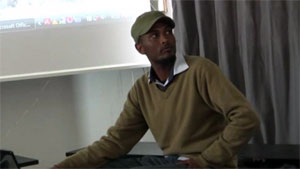
Berhanu Ashagrie Deribew
Berhanu Ashagrie Deribew presents his work with an emphasis on its relation to Addis Ababa. The discussion begins by examining his photographic work as a process for collecting information on Addis Ababa’s changing landscapes, and then moves on to discuss the video works that resulted from the photographs.
Short biographyBerhanu Ashagrie Deribew, artist, head of Addis Ababa University Alle School of Fine Arts and Design, within the Skunder Boghossian College of Performing and Visual Arts. His interests focus on process-based creative practices and time-based art education. He has exhibited in Ethiopia as well as abroad in the Netherlands, Georgia, Greece, and France, with physical art formations and creative documentations.
Berhanu Ashagrie Deribew stellt seine Zusammenarbeit mit dem Institut für Raumexperimente vor und legt dabei den Fokus auf Addis Abebas urbane Strukturen. Die Diskussion beginnt mit einer Untersuchung seiner fotografischen, prozessorientierten Arbeit, bei dem er Informationen über die sich verändernde Stadtlandschaft Addis Abebas sammelt. Schließlich präsentiert er Videoarbeiten die aus diesen Fotografien entstanden.
KurzbiografieBerhanu Ashagrie Deribew, Künstler, Leiter der Alle School of Fine Arts and Design am Skunder Boghossian College of Performing and Visual Arts an der Addis Abeba University. Seine Interessen konzentrieren sich auf prozessbasierte kreative Praktiken und zeitbasierte Medien im Bereich der Kunstausbildung. Seine Kunstinstallationen und kreativen Dokumentationen wurden sowohl in Äthiopien als auch in den Niederlanden, Georgien, Griechenland und Frankreich ausgestellt.
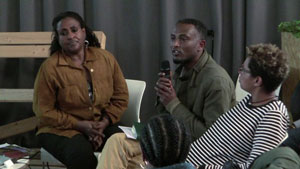
Berhanu Ashagrie Deribew
Berhanu Ashagrie Deribew’s presentation focuses on the Alle School of Fine Arts and Design and its present and future challenges. He discusses artworks that challenge the physicality of the city and raises the question of how to go beyond this physicality by exploring the artwork’s performativity and by working with words – not in an illustrative sense, but in a way that challenges the space.
Synthesis
Alle School of Fine Arts and Design • Description of the work and ethos of the school • Previous projects • The physicality of the space • Expand...
Alle School of Fine Arts and Design • Description of the work and ethos of the school • Previous projects • The physicality of the space • Performativity of the artwork • Thinking the city beyond its physicality • Working with words • Description of work with words • here-and-now
Short biography
Berhanu Ashagrie Deribew’s presentation focuses on the Alle School of Fine Arts and Design and its present and future challenges. Expand...
Berhanu Ashagrie Deribew’s presentation focuses on the Alle School of Fine Arts and Design and its present and future challenges. He discusses artworks that challenge the physicality of the city and raises the question of how to go beyond this physicality by exploring the piece’s performativity and by working with words – not in an illustrative sense, but in a way that challenges the space.
Berhanu Ashagrie Deribew konzentriert sich in seiner Präsentation auf die Alle School of Fine Arts and Design mit ihren gegenwärtigen und zukünftigen Aufgaben und Hürden. Er bespricht Kunstwerke, die die Körperlichkeit der Stadt hinterfragen. Weiterführend fragt er, wie man über diese Körperlichkeit durch eine Betrachtung der Performativität des Werkes und die Arbeit mit Sprache hinausgehen kann – nicht im illustrativen Sinne, sondern auf eine Art, die den Raum selbst herausfordert.
Synthesis
Alle School of Fine Arts and Design • Beschreibung der Arbeit und des Ethos der Schule • Frühere Projekte • Die Körperlichkeit des Raumes • Expand...
Alle School of Fine Arts and Design • Beschreibung der Arbeit und des Ethos der Schule • Frühere Projekte • Die Körperlichkeit des Raumes • Performativität des Kunstwerkes • Die Stadt über ihre Körperlichkeit hinaus denken • Arbeit mit Sprache • Beschreibung von Arbeit mit Worten • here-and-now
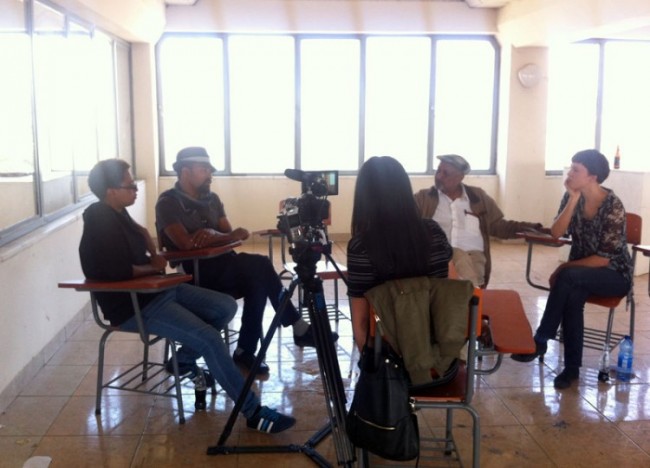
A-B-A-B-A : from here to hear (workshop)
A-B-A-B-A : from here to hear is the third experimental get-together of poets, musicians and translators based in Addis Ababa and in Berlin, who join in this exercise of styles taking place at the Alle School of Fine Arts and Design. Testing new structures and methods in a dialogue, the workshop sets out to explore oral traditions in Amharic poetry culture, translations and interpretations between German, English and Amharic, and performative elements on stage, including music traditions from traditional Ethiopian music, jazz elements and contemporary electronic music.
Participating artist: Clara Jo (artist, Berlin), Mihret Kebede (poet, Addis Abeba), Erica Licht (poet, Addis Ababa), Robert Lippok (musician, Berlin), Bekele Mekonnen (poet, Addis Ababa), Nebiy Mekonnen (poet/translator, Addis Ababa), Abebaw Melaku (poet, Addis Abeba), Rike Scheffler (poet, Berlin), Misrak Terefe (poet, Addis Abeba), Moseb Traditional Music Band (Addis Ababa), and Christina Werner (Berlin).
This event is choreographed by Mihret Kebede and Christina Werner as part of Acting Archives, a project by the Institut für Raumexperimente, Berlin University of the Arts and the Alle School of Fine Arts and Design, Addis Ababa University, supported by Studio Olafur Eliasson, and funded by the TURN Fund of the German Federal Cultural Foundation.
A-B-A-B-A : from here to hear ist die dritte experimentelle Lyrikveranstaltung, die Dichter, Musiker und Übersetzer aus Addis Abeba und Berlin im Rahmen dieser Stilübungen zusammenbringt. Der Workshop findet an der Alle School of Fine Arts and Design statt. Dort werden neue Strukturen und Methoden im gemeinsamen Dialog getestet: der Workshop lädt ein, sich mit der Tradition mündlicher Überlieferung in der amharischen Poesie-Kultur zu befassen, mit Übersetzungen und Interpretationen zwischen Deutsch, Englisch und Amharisch als auch mit performativen Aufführungselementen, mit Musiktraditionen der traditionellen äthiopischen Musik, Jazz-Elementen und zeitgenössicher elektronischen Musik.
Teilnehmende Künstler: Clara Jo (artist, Berlin), Mihret Kebede (poet, Addis Abeba), Erica Licht (poet, Addis Ababa), Robert Lippok (musician, Berlin), Bekele Mekonnen (poet, Addis Ababa), Nebiy Mekonnen (poet/translator, Addis Ababa), Abebaw Melaku (poet, Addis Abeba), Rike Scheffler (poet, Berlin), Misrak Terefe (poet, Addis Abeba), Moseb Traditional Music Band (Addis Ababa), and Christina Werner (Berlin).
Eine Veranstaltung, choreographiert von Mihret Kebede and Christina Werner, im Rahmen von Acting Archives, einem Projekt des Instituts für Raumexperimente der Universität der Künste Berlin und der Alle School of Fine Arts and Design, Addis Ababa University, unterstützt durch Studio Olafur Eliasson, gefördert im Fonds TURN der Kulturstiftung des Bundes.
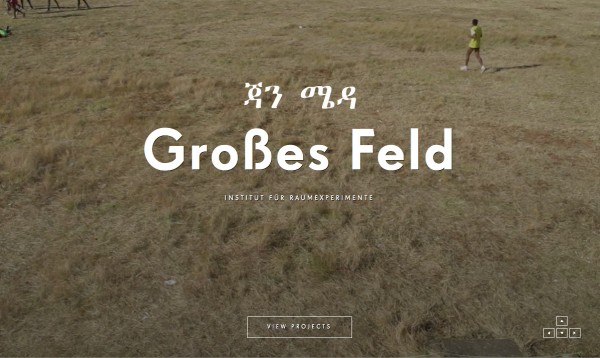
Jan Meda – Großes Feld
The Institut für Raumexperimente hosts a three-day art festival at Jan Meda, the former horse race track in Addis Ababa. The exhibition includes works by artists from Addis Ababa and Berlin. By facilitating the collaborative engagement of a unique group of artists and cultural producers, the programme creates an atmosphere of experimentation, friction, and radical movement that challenges the norms by which we create art, live together, and, thus, produce reality. Works include pavilions installed in the field, video, painting, sculpture and photography, installations, performances, workshops for children, a light sound workshop, cooking experiments, a lecture and film program, and a poetry jazz event.
Contributions by: AEAEAEAE, Malte Bartsch, Julius von Bismarck, Rune Bosse & Addis Ababa University Football Club, Merlin Carter, Julian Charrière, Leon Eixenberger, Leon Eixenberger, Eric Ellingsen, Tomas Espinosa, Henok Getachew, Tamrat Gezahegne, Andreas Greiner, Markus Hoffmann, Rike Horb, Clara Jo, Hans-Henning Korb, Mihret Kebede, Felix Kiessling, Fabian Knecht, Norgard Kröger, Robert Lippok, Felix Meyer, Simen Museus, Molly Nesbit, Lynn Peemoeller, Vinzenz Reinecke, Nina Schuiki, Robel Temesgen, Alkistis Thomidou, Raul Walch, Jonas Wendelin, Christina Werner, Euan Williams, Helen Zeru
View exhibition website.
Program:
13 December: Opening DayPerformances and walks by Eric Ellingsen, Simen Museus & Hans-Henning Korb, Henok Getachew, Rune Bosse & Robel Temesgen, Julian Charrière.
14 December: Film ScreeningVideo works by artists from Addis Abeba and Berlin: Eric Ellingsen, Fabian Knecht, Merlin Carter, Felix Meyer, Robel Temesgen, Raul Walch, and Jonas Wendelin
14 December: Conversation with Molly NesbitLecture at the exhibition
Click to view the video documentation of Molly Nesbit’s lecture Doubts and Habits of Actions in Time.
15 December: Ishe get ‘um, OK PoetryPoetry readings and performances by Eric Ellingsen, Mihret Kebede, Misrak Terefe, Abebaw Melaku, Demissew Mersha, Vinzenz Reinecke, Tadele Tewodros, and Addis Taem Band
Click to view the video documentation of the poetry performances.
Das Institut für Raumexperimente richtet ein dreitägiges Kunstfestival auf der früheren Pferderennbahn, Jan Meda, in Addis Abeba aus. Die Ausstellung zeigt Werke von Künstlern aus Addis Abeba und Berlin. So wird eine besondere Begegnung und Zusammenarbeit einer Gruppe von Künstlern und Kulturschaffenden ermöglicht. Hierdurch schafft das Festival eine experimentelle und spannungsgeladene Atmosphäre mit Offenheit für radikale Schritte. Normen nach denen wir Kunst machen, zusammen leben und Realität produzieren werden so in Frage gestellt. Die Arbeiten umfassen unter anderem Pavillons auf der Rennbahn, Video, Malerei, Skulptur und Fotografie, Installationen, Performances, Workshops für Kinder, einen Workshop mit Licht und Resonanz, Kochexperimente, ein Vorlesungs- und Filmprogramm sowie ein Jazz-Poetry Event.
Mit Beiträgen von: AEAEAEAE, Malte Bartsch, Julius von Bismarck, Rune Bosse & Addis Ababa University Football Club, Merlin Carter, Julian Charrière, Leon Eixenberger, Leon Eixenberger, Eric Ellingsen, Tomas Espinosa, Henok Getachew, Tamrat Gezahegne, Andreas Greiner, Markus Hoffmann, Rike Horb, Clara Jo, Hans-Henning Korb, Mihret Kebede, Felix Kiessling, Fabian Knecht, Norgard Kröger, Robert Lippok, Felix Meyer, Simen Museus, Molly Nesbit, Lynn Peemoeller, Vinzenz Reinecke, Nina Schuiki, Robel Temesgen, Alkistis Thomidou, Raul Walch, Jonas Wendelin, Christina Werner, Euan Williams, Helen Zeru
Website der Ausstellung besuchen.
Programm:
13. Dezember: EröffnungPerformances und Walks von Eric Ellingsen, Simen Museus & Hans-Henning Korb, Henok Getachew, Rune Bosse & Robel Temesgen, Julian Charrière.
14. Dezember: FilmabendVideos von Künstlern aus Addis Abeba und Berlin: Eric Ellingsen, Fabian Knecht, Merlin Carter, Felix Meyer, Robel Temesgen, Raul Walch und Jonas Wendelin
14. Dezember: Molly Nesbit: Doubts and Habits of Actions in TimeVortrag in der Ausstellung
Hier zur Videodokumentation des Vortrags von Molly Nesbit.
15 December: Ishe get ‘um, OK PoetryLesungen und Performances von Eric Ellingsen, Mihret Kebede, Misrak Terefe, Abebaw Melaku, Demissew Mersha, Vinzenz Reinecke, Tadele Tewodros und der Addis Taem Band
Die Videodokumentation der Performances anschauen.
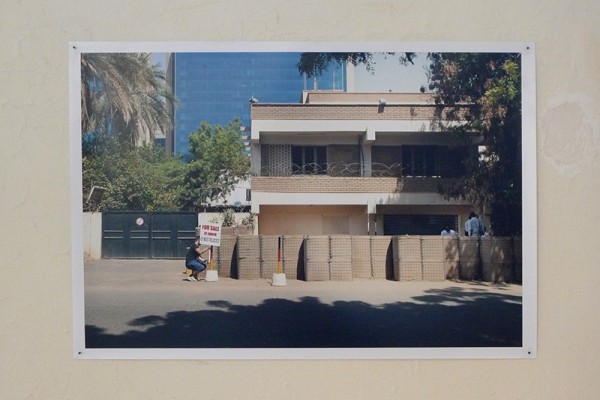
Addis Foto Fest
The Institut für Raumexperimente is invited to participate in the Addis Foto Fest 2012. Established in 2010, the Addis Foto Fest is a biennial photography festival directed by photographer Aida Muluneh. Produced by Desta for Africa (DFA), the weeklong international festival is held in Addis Ababa, Ethiopia, and features exhibitions, portfolio reviews, conferences, projections, and film screenings.
The works contributed by the Institut für Raumexperimente are exhibited at the Alle School of Fine Art and Design, Addis Ababa University, with several interventions taking place in public space.
Works and interventions by Malte Bartsch; Julius von Bismarck; Rune Bosse; Julian Charrière and Julius von Bismarck; Eric Ellingsen and Fabian Knecht; Leon Eixenberger; Leon Eixenberger and Hans-Henning Korb; Markus Hoffmann; Jonas Wendelin; Felix Kiessling; Fabian Knecht; Vinzenz Reinecke and Merlin Carter; Nina Schuiki; Raul Walch; and Christina Werner, Alkistis Thomidou, Helen Zeru and Norgard Kröger
Das Institut für Raumexperimente ist eingeladen am Addis Foto Fest 2012 teilzunehmen. Gegründet im Jahr 2010 ist das Addis Foto Fest ein alle zwei Jahre stattfindendes Festival für Fotografie unter der Leitung der Fotografin Aida Muluneh. Das einwöchige Festival ist eine Produktion von Desta for Africa (DFA) und findet in Addis Abeba, Äthiopien statt. Teil des Programms sind Ausstellungen, Portfoliobesprechungen, Konferenzen, Projektionen und Filmvorführungen.
Die Arbeiten des Instituts für Raumexperimente sind an der Alle School of Fine Art and Design der Addis Abeba University zu sehen. Mehrere Events finden außerdem im öffentlichen Raum statt.
Arbeiten und Interventionen von Malte Bartsch; Julius von Bismarck; Rune Bosse; Julian Charrière und Julius von Bismarck; Eric Ellingsen und Fabian Knecht; Leon Eixenberger; Leon Eixenberger und Hans-Henning Korb; Markus Hoffmann; Jonas Wendelin; Felix Kiessling; Fabian Knecht; Vinzenz Reinecke und Merlin Carter; Nina Schuiki; Raul Walch; und Christina Werner, Alkistis Thomidou, Helen Zeru und Norgard Kröger